Cal Poly Humboldt’s Student-Run Bilingual Newspaper
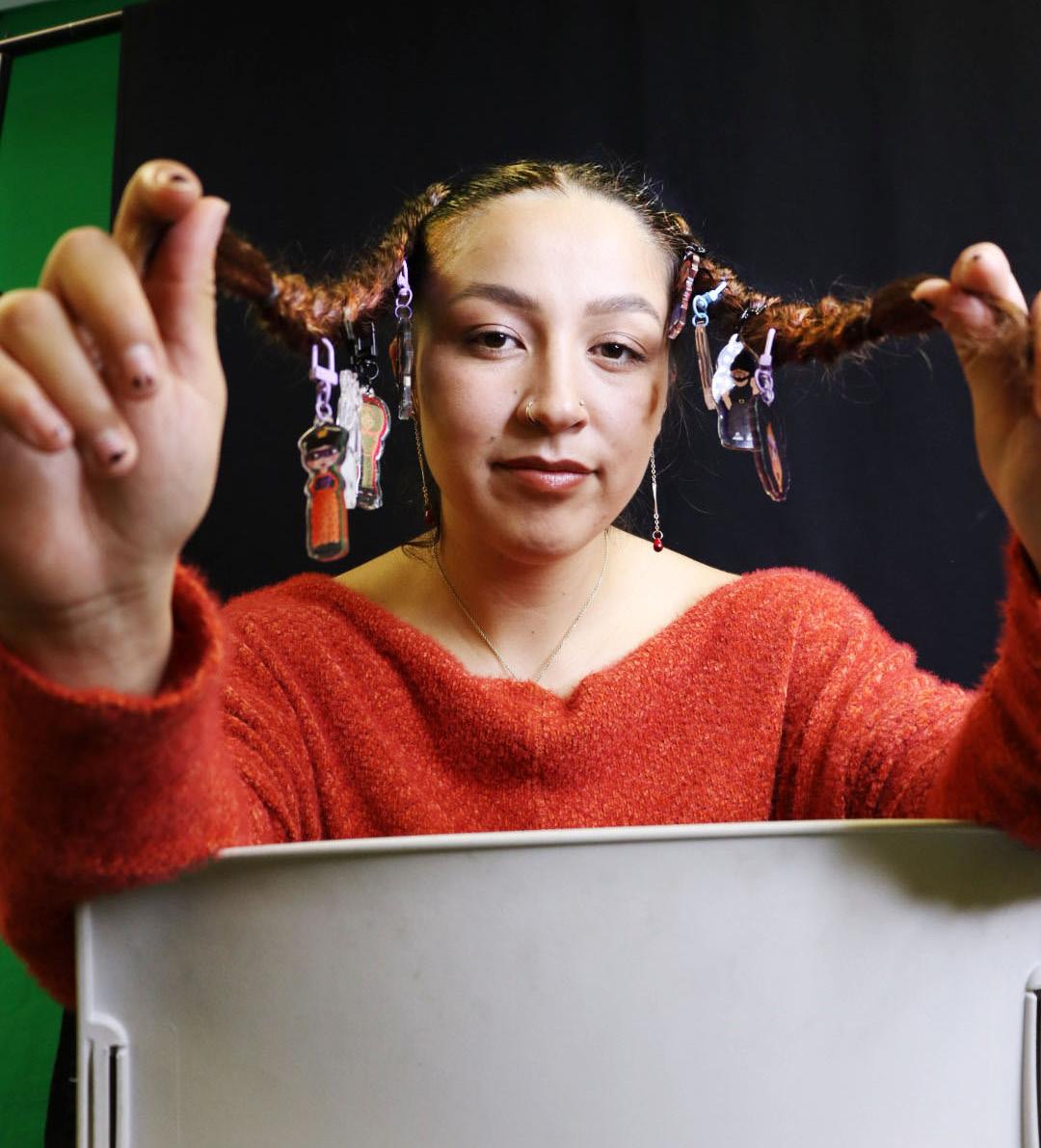
abril 2025
Vol. 24 Edición 3

Cal Poly Humboldt’s Student-Run Bilingual Newspaper

abril 2025
Vol. 24 Edición 3
CPH under investigation for alleged DEI discrimination p. 03
Toyon set to release April 16 despite backlash p. 05
Latino Chamber of Commerce p.09
EOP apoya a estudiantes de primer generación p. 07
Charla de Salud con Jessica: respuesta de adulación p. 22
Como me ha afectado la depresión p.21

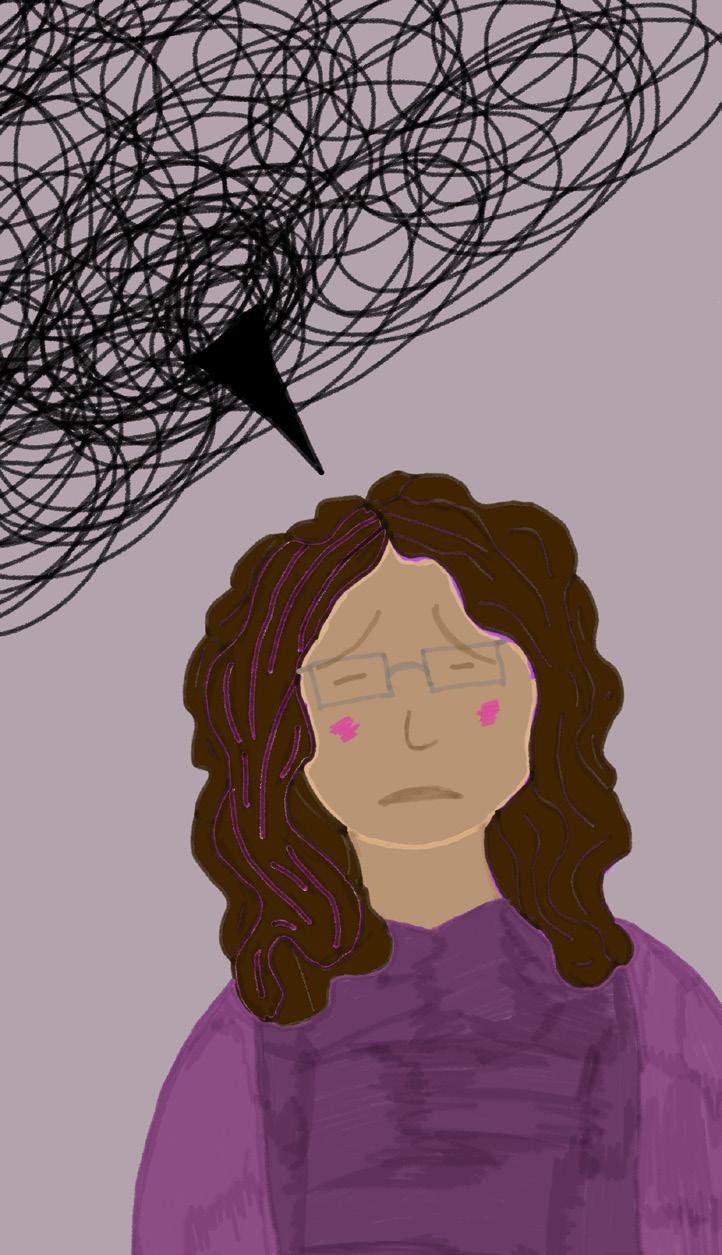

03 CPH under investigation for alleged DEI based discrimination
05 New Toyon literary magazine set to release April 16 despite backlash
06 Educational Opportunity Program supports frst generation and low income students
09 Latino Chamber of Commerce
10 Number of Latine faculty on campus
12 Soy Artista: Dope Soul Studios creator Izzy Starr
13 A look into local community members cultural tattoos and signifcances
21 How depression has afected me and how I live with it
15 ‘Mickey 17’ movie review: another tale of late-stage capitalism
19 RFK Jr. is trying to police ‘junk food’ bought with EBT dollars
22 Health Talk with Jessica: Submissive under stress? It may be a trauma response
04 CPH bajo investigación por presunta discriminacion basada en DEI
05 La nueva revista literaria Toyon se lanzará el 16 de abril a pesar de las críticas
07 Programa de oportunidad educativa apoya a estudiantes de primer generación y de bajo ingresos
23 Charla de salud con Jessica: ¿Sumiso bajo el estrés? Puede ser una respuesta al trauma
El Leñador is an English and Spanish newspaper produced by Cal Poly Humboldt students. Our staff cover and provide news to Latinx and other diverse communities on campus and in Humboldt County. We are committed to providing relevant news and expanding the representations and stories told about people of color and other marginalized groups. Our work helps create more social, political and cultural diversity in local media.
El Leñador es un periódico en español e inglés producido por estudiantes de Cal Poly Humboldt. Nuestro personal cubre y provee noticias a la comunidad Latine y otras comunidades diversas en el campus y en el condado de Humboldt. Estamos comprometidos a brindar noticias actuales y ampliar la representación y las historias que son contadas sobre la gente de color y otros grupos marginados. Nuestros esfuerzos ayudan a crear una diversa presencia social, política y cultural en los medios locales.


Editor in Chief
Maryanne Casas-Perez
Managing Editor
Noelle Doblado
News Editor
Vanessa Saltos
Life & Arts Editor
Ben Hernandez
Layout/Design
Maryanne Casas-Perez
Jordan Pangelinan
Noelle Doblado
Ben Hernandez
Ryndi Greenwell
Writers/Contributors
Ocean Edgar Ryndi Greenwell
Henry Lagunas
Kimberly Madrigal
Joahnna Tool
Alba Galvan
Jessica De Laguna Giancarlo Munoz
Kumiye Nakadate Ryan Diaz
Translators
Clari Gomez
Yocelin Rios
Marisabel Perez Moreno
Gina Muñoz Villanueva
Distribution
Guillermo Noe Salazar
Andrea Juarez
photo by Vanessa Saltos foto por Vanessa Saltos
To advertise with us, email ellenador.ads@gmail.com
El Leñador staf can be reached at el-lenador@humboldt.edu
by Noelle Doblado
On March 14, The U.S Department of Education launched investigations into alleged race-based discrimination at three California universities and 49 other colleges nationwide including Cal Poly Humboldt.
“Dear Colleague” letter
The Department of Education’s Office for Civil Rights (OCR) issued a letter on Feb.14 threatening to cut federal funding for schools that supported Diversity, Equity and Inclusion (DEI) programs and efforts. The letter did not state which specific federal funds for schools and colleges are at risk.
The letter states, “The Department will no longer tolerate the overt and covert racial discrimination that has become widespread in this Nation’s educational institutions. The law is clear: treating students differently on the basis of race to achieve nebulous goals such as diversity, racial balancing, social justice, or equity is illegal under controlling Supreme Court precedent.”
The OCR stated in the letter that American educational institutions have discriminated against students on the basis of race, specifically targeting white and Asian students. The letter listed examples of alleged race based discrimination on campuses which include factors in admissions, financial aid, hiring, training, institutional programming, graduation ceremonies, dormitories and other facilities.
University’s response
On March 25, Cal Poly Humboldt’s interim president Micheal Spagna issued an email in response to the launched investigation. The email recognizes two recent incidents of alleged violations of Title VI, which prohibits discrimination on the basis of race, color and national origin in programs and activities receiving federal financial assistance. These include The U.S. OCR’s investigation into CPH as well as a federal complaint filed by the Brandeis Center, a non profit Jewish civil rights group, for discrimination against Jewish students on campus.
In the email Spagna states, “We take
these allegations seriously, and we want to assure you that we are working closely with the California State University (CSU) system to address them. We will also fully cooperate with the Department of Education's Office for Civil Rights during their investigation. Consistent with California law and federal civil rights laws, the CSU provides equal opportunity in education and employment without unlawful discrimination or preferential treatment based on race, sex, color, ethnicity, or national origin. All university programs and activities are open to all.”
ODEI and CRGS perspectives
The following quotes are from before the OCR investigation was launched. As of now there are no new updates on the investigation.
The Office for Diversity Equity and Inclusion (ODEI) on campus works to engage and support students from diverse spectrums. Rosamel S. Benavides-Garb, the associate vice president of ODEI and campus diversity officer, shared that ODEI and the university are actively engaging in conversations in response to the current presidential administration but no specific plans are in place.
“We are not a federally funded office, we are state funded as a public university, so we are not related to that particular narrative that DEI is bad or has been criminalized. There are reasons for why DEI has been criminalized by the current [presidential] administration,” Benavides-Garb said. “So no, we have not been impacted or made modifications, we are concerned though, we are concerned about what is going on nationally, what is going on with the actual work of supporting our communities across the nation.”
Benavides-Garb recognizes the importance of Proposition 209 in California during discussions about DEI in schools. In 1996, Proposition 209 amended the state constitution to prohibit state governmental institutions from considering race, sex or ethnicity in hiring, admissions or contracting.
“For nearly 30 years, California and the CSU system has not discriminated because the law does not allow for that. So
when the new administration tells that the DEI discriminates, we know we don’t. We have been consistently and institutionally, been a non discriminating public system,” Benavides-Garb said.
Earlier this year, President Donald J. Trump ordered U.S. schools to prohibit teaching what he believes as “critical race theory” and other curriculum that discusses race and sexuality, at the risk of schools losing their federal funding.
Roberto Monico, a professor in the Critical Race, Gender and Sexuality studies department (CRGS) that teaches courses concentrated in ethnic studies, shared that there are ongoing conversations with the university amidst the presidential administration’s orders.
“We are keeping up to date with what the [presidential] administration is trying to do, it's just a lot of divide and conquer,” Monico said. “I feel confident that a lot of my colleagues are going to speak up and
support us.”
Monico believes courses in CRGS are critical for highlighting diverse narratives and that historically, people in power have attempted to silence them.
“We’ve been here before. For a lot of young people they've never experienced this before, so it makes them quite nervous. These are the things we talk about in our courses, at least in my classes to give them inspiration and hope that we can work together,” Monico said.
In addition, Benavides-Garb strongly believes that the function of ODEI on campus is valuable and necessary to support the communities of our campus and nation.
“We have a deep sense of duty and responsibility,” Benavides-Garb said. “I know these are difficult times but actually these times confirm more than ever, our purpose.”

Graphic by Kumiye Nakadate
Escrito por Noelle Doblado y traducido por Marisabel Perez Moreno
El 14 de marzo, el Departamento de Educación de los Estados Unidos (ED) lanzó investigaciones por presunta discriminacion basadas en raza contra tres universidades de California y 49 universidades a nivel nacional, incluyendo a Cal Poly Humboldt (CPH).
Carta “Querido Colega”
La Oficina de Derechos Civiles del Departamento de Educación emitió una carta el 14 de febrero amenazando con cortar los fondos federales en escuelas que apoyen programas de Diversidad, Equidad, e Inclusión (DEI). La carta no indicó qué fondos federales específicos para las escuelas y universidades están en riesgo.
La carta dice: “El Departamento ya no tolerará la discriminacion racial excesiva y encubierta que se ha generalizado en las instituciones educativas de esta Nación.
La ley es clara: tratar a los estudiantes de manera diferente en base de la raza para lograr objetivos nebulosos como la diversidad, el equilibrio racial, la justicia social o la equidad es ilegal bajo la precedencia de la Corte Suprema”.
La Oficina de Derechos Civiles del Departamento de Educación declaró en la carta que las instituciones educativas estadounidenses han discriminado a los estudiantes por motivo de raza, específicamente dirigidos contra estudiantes blancos y asiáticos. La carta nombra ejemplos de supuesta discriminacion basada en la raza en los campus, que incluyen factores en las admisiones, la ayuda financiera, la contrataciones, el entrenamiento, los programas institucionales, las ceremonias de graduaciones, los dormitorios, y otras instalaciones.
Respuesta de la universidad
El 25 de marzo, el presidente interino Micheal Spagna de Cal Poly Humboldt emitió un correo electrónico en respuesta al inicio de la investigación. El correo electrónico reconoce dos incidentes recientes de presuntas violaciones del Título VI, que prohibe la discriminacion en base de la raza, color, y origen nacional en programas y actividades que reciben asistencia financiera federal. Incluye la investigación de ED contra CPH y el reclamo federal ingresado por el Centro Brandeis, un grupo judio
de derechos civiles sin fines de lucro, por discriminacion contra los estudiantes judios en el campus.
En el correo electrónico Spagna dijo, “Nos tomamos muy en serio estas acusaciones y queremos asegurarles que estamos trabajando con el sistema de la Universidad Estatal de California (CSU) para abordarlas. También estaremos cooperando completamente con la Oficina de Derechos Civiles del Departamento de Educación durante su investigación. De conformidad con la ley de California y las leyes federales de derechos civiles, la CSU brinda oportunidades de igualdad en educacion y empleo sin discriminaciones ilegal ni trato de preferencia basada en la raza, el sexo, color, ethnicidad, o el origen nacional. Todos los programas universitarios y actividades están disponibles para todos”.
Perspectivas de ODEI y CRGS
Las siguientes citas son de antes de que se iniciara la investigación OCR. Hasta el momento no hay nuevas actualizaciones sobre la investigación.
La Oficina para la Diversidad, Equidad, y la Inclusión (ODEI) en el campus trabaja para involucrar y apoyar a los estudiantes de diversos espectros. Rosamel S. Benavides-Garb, vicepresidente asociado de ODEI y oficial de diversidad del campus, compartió que ODEI y la universidad están participando activamente en conversaciones en respuesta a la administración presidencial actual, pero no detallaron planes específicos que se llevarán a cabo.
“No somos una oficina financiada con fondos federales, somos fundados por el estado como una universidad pública, así que no estamos relacionados a esa narrativa que DEI es malo o que debe de ser criminalizada. Hay razones por las cuales DEI está siendo criminalizada actualmente por la administración [presidencial]”, Benavides-Garb dijo. “Así que no, no fuimos impactados o hecho modificaciones; aunque estamos preocupados, estamos preocupados sobre lo que está ocurriendo nacionalmente, y lo que está ocurriendo con el trabajo de apoyar a nuestras comunidades entre toda la nación”.
Benavides-Garb reconoce la importancia de la Proposición 209 en California durante la discusión de DEI en escuelas.

En 1996, Proposición 209 enmendó la constitución estatal para prohibir que las instituciones gubernamentales estatales consideren la raza, el sexo, o el origen etnico en la contratacion o admision.
“Por casi 30 años, California y el sistema de la CSU no han discriminado porque la ley no lo permite. Así que cuando la nueva administración dice que DEI discrimina, sabemos que no lo hacemos. Hemos sido consistente e institucionalmente, un sistema público sin discriminacion”, dijo Benavides-Garb.
A principios de este año, el presidente Donald J. Trump ordenó a las escuelas de EE.UU. que prohibieran la enseñanza de lo que él cree como “teoría crítica de la raza” y otros currículos que discuten la raza y la sexualidad, a riesgo de que las escuelas pierdan sus fondos federales. Roberto Monico, un profesor en el departamento de Estudios Críticos de la Raza, el Género y la Sexualidad (CRGS) que enseña cursos concentrados en Estudios Étnicos, compartió que continúan teniendo conversaciones con la universidad de acuerdo con las órdenes de la administración presidencial.
“Nos estamos manteniendo al tanto de lo que está tratando de hacer la administración [presidencial], es mucha división y conquista”, dijo Monica. “Tengo confianza que muchos de mis colegas van a alzar la voz y apoyarnos”.
Monica cree que los cursos de CRGS son críticos para iluminar las narrativas diversas y que históricamente, las personas en poder han intentado silenciarlos.
“Hemos estado aquí antes. Muchas personas jóvenes no han tenido este tipo de experiencias antes, así que los hace sentir nerviosos. Estas son cosas que platicamos en nuestros cursos, por lo menos en mis clases, para darles inspiración y esperanza de que podemos trabajar juntos”, dijo Monica.
Benavides-Garb cree firmemente que la función de ODEI en el campus es valioso y necesario para apoyar a las comunidades de nuestro campus y de la nación.
“Tenemos una gran sensación de deber y responsabilidad”, Benavides-Garb dijo. “Se que estos son tiempos difíciles pero en realidad, estos tiempos confirman más que nunca nuestro propósito”.
by Ben Hernandez
Cal Poly Humboldt’s literary magazine, Toyon, will be celebrating the release of their 71st issue, “Dispatches from the Global Intifada,” with an event in the Goodwin Forum on April 16 from 1-4 p.m.
The event is free and open to the public, it will include live readings from the authors and an awards ceremony.
Toyon is a multilingual journal of literature and art that is edited and produced by Cal Poly Humboldt students from different majors.The new issue is centered on the collective movements for the liberation of Palestine. The issue covers a wide range of contributors’ voices featuring poetry, collage, prose, protest journalism and original artwork.
“The work that Toyon does in general…it’s about building a literary community both within and beyond the university,” said Toyon assistant manager Chrys Furrer. “And in particular with this issue is about building a movement and gathering people up with the movement towards liberation.”
Holly Rae is a graduate student and publisher for Toyon. In regards to the title of this issue, Rae shared that, “The word intifada was something that we felt strongly about using.” Intifada is an Arabic word which means ‘uprising’ or ‘shaking off’.
“It’s an embodied word,” Rae said.
However, the title was the cause of some upset. Marcos Hernandez, the faculty advisor for Toyon, shared that the English department received multiple emails and phone calls early in the Fall semester from a student claiming to be a speaker on behalf of all Jewish students on campus and demanding the name be changed.
“Early on Toyon adopted a policy of non-engagement,” Hernandez said. “We felt that it was important for our department and our upper administration to take up this issue…we didn’t feel like anything good was going to come out of engaging with this group of students.”
In a later email the student also demanded that the project be shut down altogether and that the student staff
and faculty advisor be reprimanded for their work on the magazine.
“Ultimately what resulted from that was a recognition that we’re operating within the bounds of free speech and free expression as students, as a student publication and so we went full steam ahead,” Rae said.
For Rae, she hopes the issue will foster community and perpetuate the conversation of liberation in Palestine.
“We know that not everyone will agree with us, but that’s also the role that art plays in the development of culture over time,” Rae said. “Sometimes it’s controversial.”
The majority of submissions are from students and Humboldt locals, however some are international. This issue features submissions in English, Spanish, Arabic, Italian and French.
“This is truly a global effort that went into this book,” Rae said.
Toyon 71 will be available in print and digital formats on April 16. For more information you can follow Toyon on Instagram @toyonlitmag.
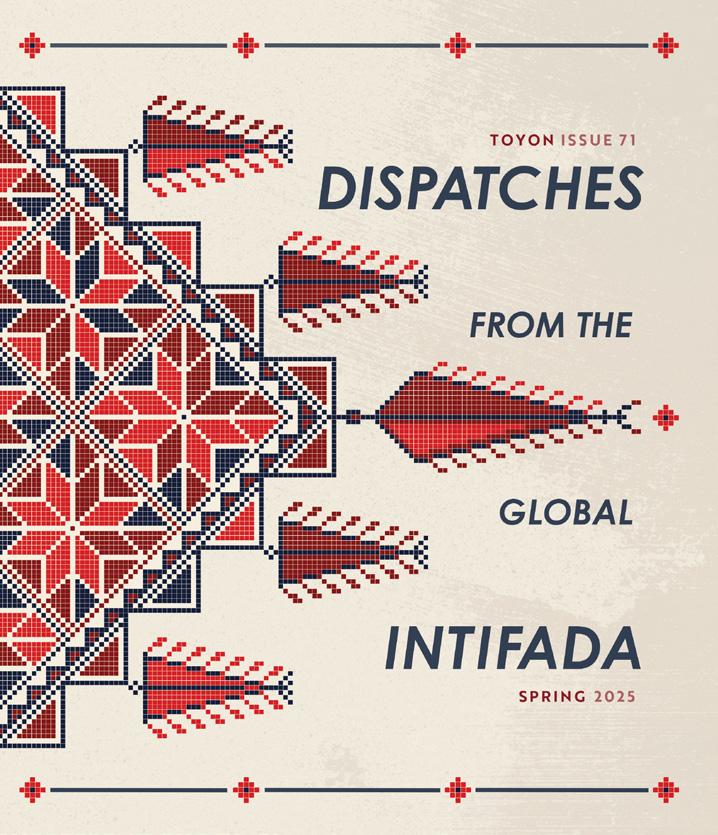
Toyon’s 71st issue, titled, “Dispatches from the Global Intifada” | Image courtesy of Marcos Hernandez.
Número 71 de Toyon, titulado "Despachos desde la Intifada Global" | Imagen cortesía de Marcos Hernández.
Toyon, la revista literaria de Cal Poly Humboldt, celebrará el lanzamiento de su número 71, "Despachos desde la Intifada Global", con un evento en el Goodwin Forum el 16 de abril, de las 1-4 p.m.
El evento es gratuito y abierto al público, e incluirá lecturas en vivo de los autores y una ceremonia de premios.
Toyon es una revista multilingüe de literatura y arte editada y producida por estudiantes de Cal Poly Humboldt de diferentes carreras. La más reciente edición se centra en los movimientos colectivos por la liberación Palestina. La edición abarca una amplia gama de voces de colaboradores a través de poesía, collage, prosa, periodismo de protesta y obras de arte originales.
"El trabajo que realiza Toyon en general... se centra en construir una comunidad literaria tanto dentro como fuera de la universidad", dijo Chrys
Furrer, subdirectora de Toyon. “Y en particular, esta edición trata sobre construir un movimiento y unir a la gente al movimiento hacia la liberación”.
Holly Rae es estudiante de posgrado y editora de Toyon. Respecto al título de este número, Rae compartió, “Nos sentimos fuertemente sobre la palabra intifada”. Intifada es una palabra árabe que significa ‘levantamiento’ o ‘desprendimiento’.
“Es una palabra personificada”, dijo Rae.
Sin embargo, el título molestó a algunas personas. Según Marcos Hernández, asesor académico de Toyon, el departamento de inglés recibió múltiples correos electrónicos y llamadas telefónicas a principio del semestre de otoño de un estudiante que decía ser el representante de todos los estudiantes judíos del campus y exigía que se cambiara el nombre.
“Desde el principio, Toyon adoptó una política de no interactuar”, dijo Hernández. “Creíamos que era importante que nuestro departamento y la administración aceptaran esta política … no creíamos que nada positivo saliera de interactuar con este grupo de estudiantes”.
En un correo electrónico posterior, la estudiante también exigió que el proyecto se cancelara por completo y que el personal estudiantil y el asesor académico fueran reprendidos por su trabajo en la revista.
“En última instancia, el resultado fue reconocer que, como estudiantes y como publicación estudiantil, actuamos dentro de los límites de la libertad de expresión, y por eso seguimos adelante”, dijo Rae.
Rae espera que este número fomente el sentido de comunidad y perpetúe el debate sobre la liberación en Palestina.
“Sabemos que no todos estarán de acuerdo con nosotros, pero ese también es el papel que desempeña el arte en el desarrollo de la cultura a lo largo del tiempo”, dijo Rae. “A veces es controversial”.
La mayoría de las contribuciones provienen de estudiantes y residentes de Humboldt, aunque algunas son internacionales. Este número incluye contribuciones en inglés, español, árabe, italiano y francés.
“Este libro es un verdadero esfuerzo global”, dijo Rae. Toyon 71 estará disponible en formato impreso y digital el 16 de abril. Para más información puedes seguir a Toyon en Instagram @toyonlitmag.
by Ocean Edgar
For first generation and otherwise disadvantaged future Cal Poly Humboldt students, there have likely been many hurdles to overcome to even get as far as applying and being accepted to a university.
The Educational Opportunity Program (EOP) is a statewide program designed to help students attain their degrees and have an overall supportive and positive experience at college. EOP resides at Hadley House along with Student Support Services (SSS), under the TRIO Program.
According to the California State University website, EOP developed out of a Civil Rights era student led campaign seeking to “overcome economic and social barriers that prevented minorities and underrepresented students from attaining a college education.” The program came to Humboldt State in 1972.
Last year between spring 2024 and fall 2024, EOP recognized 280 students with honors that meet their requirement, 100 of those were on the dean’s list and 96 were presidential scholars.
Students enrolled in EOP receive additional funding and services that support them and to demystify the experience of going to college.
“Most of them are 17 or 18 years old and have never been away from home, and their parents haven’t gone to college, so navigating that is not something that’s going to come naturally to them,” said Rama Rawal, EOP and TRIO programs Director and Advisor. “They’re starting the race behind a lot of other folks.”
“EOP is for first generation low income students, and also students who, when they apply, share with us that they would like help with their academics, whether it’s with test taking, reading strategies, coaching, advising…,” Rawal said.
Once a student checks a box stating they are interested in EOP when applying to a university, the process becomes much more personalized. Students who qualify are either incoming freshman or transfer students who have been admitted to college. If students don't meet both requirements there are other programs they may qualify for which
EOP can help them with. They will have to answer questions about their financial status and provide two letters of recommendation.
When accepted into the program, advisors will reach out and guide students through the next steps, whether it be for registering for classes, filling out their FAFSA, applying for housing and more.
“We also work on their DARS with them, we try to plan out their four years with them. We have career exploration dialogue… first generation students are known to have what they call the ‘first gen jitters’, which is kind of second guessing themselves, ‘do I really belong here?’” Ramwal said.
Xelha Puc, an administrative assistant at Hadley House and a current graduate student in education, was an EOP recipient.
“Being first generation to me meant navigating this world that no one in my community knew, so I had to look for these resources on my own,” Puc said. “My parents wanted me to go straight into college but how am I supposed to do that? Unfortunately, they couldn’t help me financially, they couldn’t help me mentally, these weren’t resources my family knew.”
Besides offering academic support services, EOP can direct students to other resources on campus.
“Because EOP has been on this campus for so long we have a wonderful relationship with financial aid, the advising center and we also have really strong relationships with all the cultural centers on campus,” Rawal said.
“Rapport is really important and we offer holistic advising, which means we really hold that space for [students], whatever they need. We see them as dimensional human beings… it’s a hallmark of EOP,” Rawal said.
According to the Public Policy Institute of California, “Among full-time workers, college graduates are more likely to have jobs that offer paid vacation, health insurance, retirement, and flexible work arrangements. These forms of nonwage compensation help provide greater financial stability and security over the long run.”
As of now Puc shared that of 483 current students, 385 are on honor roll and maintaining a 3.0 or above GPA.



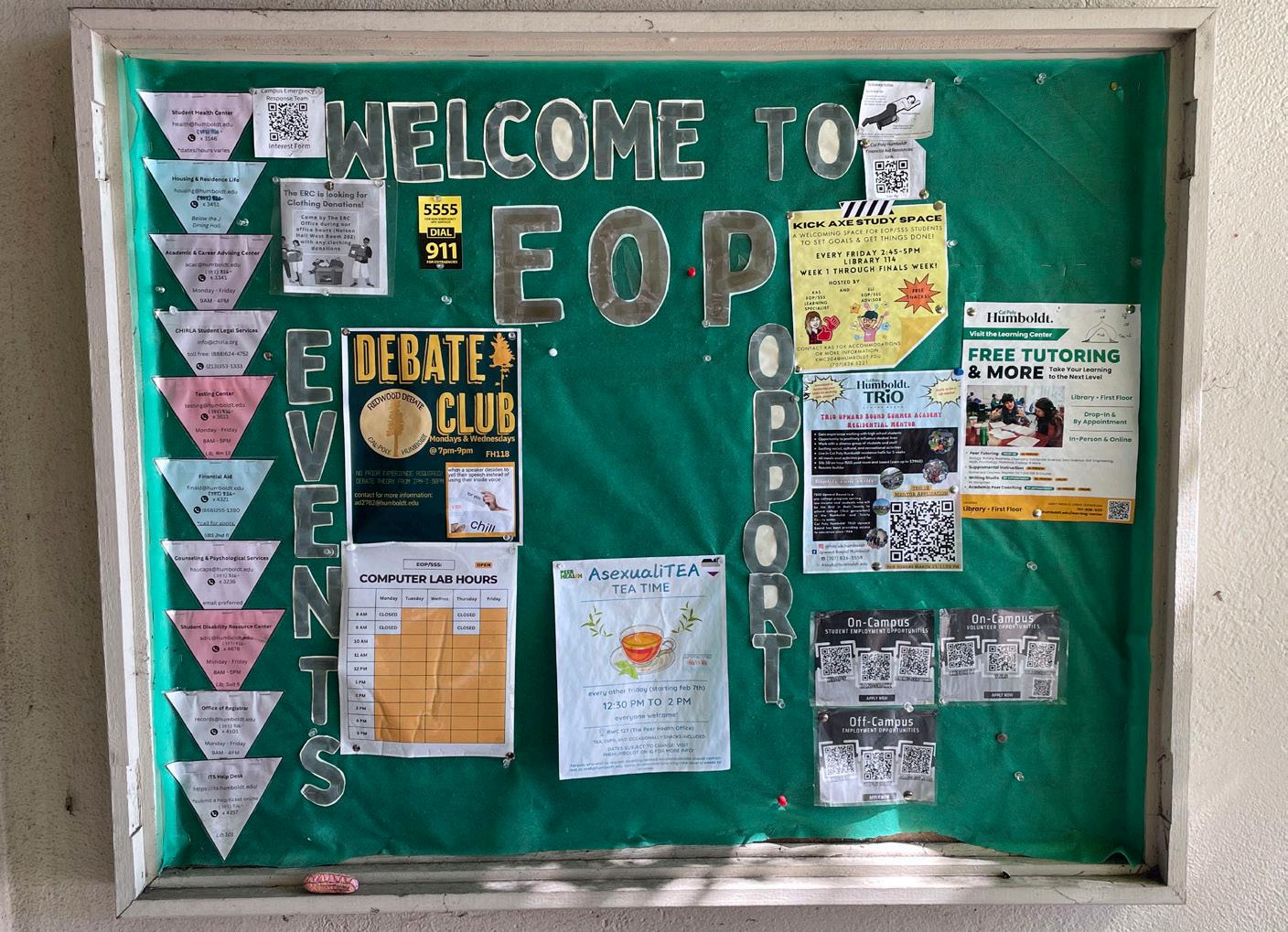
Para los futuros estudiantes de Cal Poly Humboldt de primera generación y desfavorecidos, es probable que hayan tenido que superar muchos obstáculos para llegar tan lejos como para postularse y ser aceptados en una universidad.
El Programa de Oportunidad Educativa (EOP) es un programa estatal diseñado para ayudar a los estudiantes a obtener sus títulos y tener una experiencia positiva y de apoyo general en la universidad. EOP reside en Hadley House junto con TRIO y Servicios de Apoyo Estudiantil (SSS).
Según el sitio de la Universidad estatal de California, EOP surgió de una campaña dirigida por estudiantes en la era de los derechos civiles que buscaba “superar barreras económicas y sociales que entendían que las minorías y los estudiantes subrepresentados obtuvieron una educación universitaria.” El programa llegó a Humboldt State en 1972.
El año pasado, entre la primavera de 2024 y el otoño de 2024, EOP reconoció con honores a 280 estudiantes que cumplieron con sus requisitos, 100 de ellos estaban en la lista del decano y 96 eran estudiantes presidenciales. Los estudiantes matriculados en EOP reciben fondos y servicios adicionales que los apoyan y ayudan a simplificar la experiencia de ir a la
universidad.
“La mayoría de ellos tienen 17 o 18 años y nunca han estado fuera de casa, y sus padres no han ido a la universidad, por lo que navegar eso no es algo que les resulte natural”, dijo Rama Rawal, directora y asesora de los programas EOP y TRIO. "Están comenzando la carrera detrás de muchas otras personas".
“EOP es para estudiantes de bajos ingresos de primera generación, y también para estudiantes que, cuando entregan su solicitud, comparten con nosotros que les gustaría recibir ayuda con sus estudios, ya sea para tomar exámenes, estrategias de lectura, capacitación, asesoramiento…”, dijo Rawal.
Proceso de solicitud de EOP
Una vez que un estudiante marca una caja que indica que está interesado en EOP cuando solicita ingreso a una universidad por primera vez, el proceso se vuelve mucho más personalizado. Los estudiantes que califican son estudiantes entrantes de primer año o estudiantes transferidos que han sido admitidos en la universidad. Si los estudiantes no cumplen con ambos requisitos, existen otros programas para los que pueden calificar y con los que EOP puede ayudarlos. Tendrán que responder preguntas sobre su situación
financiera y proveer dos cartas de recomendación.
Cuando sean aceptados en el programa, los asesores se comunicarán con los estudiantes y los guiarán a través de los siguientes pasos, ya sea para registrarse en clases, completar su FAFSA, solicitar dormitorios y más.
"También trabajamos con ellos en su DARS, tratamos de planificar sus cuatro años con ellos. Mantenemos un diálogo de exploración de carreras... Se sabe que los estudiantes de primera generación tienen lo que ellos llaman 'nerviosismo de primera generación', que es una especie de duda sobre ellos mismos: '¿Realmente pertenezco aquí?'", dijo Rawal.
Xelha Puc, asistente administrativa de Hadley House y actual estudiante de posgrado en educación, fue una recipiente de EOP.
“Para mí ser primera generación significó navegar en este mundo que nadie en mi comunidad conocía, así que tuve que buscar estos recursos por mi cuenta”,Puc dijo. "Mis padres querían que fuera directamente a la universidad, pero ¿cómo se supone que debo hacer eso? Desafortunadamente, no pudieron ayudarme financieramente, no pudieron ayudarme mentalmente, estos no eran recursos que mi familia conocía".
Además de ofrecer servicios de
apoyo académico, EOP puede dirigir a los estudiantes a otros recursos en el campus.
“Debido a que EOP ha estado en este campus durante tanto tiempo, tenemos una relación maravillosa con la ayuda financiera, el centro de asesoramiento y también tenemos relaciones muy sólidas con todos los centros culturales del campus”, dijo Rawal.
"La relación es realmente importante y ofrecemos asesoramiento holístico, lo que significa que realmente tenemos ese espacio para [los estudiantes], sea lo que sea que necesiten. Los vemos como seres humanos dimensionales... es un sello distintivo de EOP", dijo Rawal. Según el Instituto de Políticas Públicas de California, “Entre los trabajadores de tiempo completo, los graduados universitarios tienen más probabilidades de tener trabajos que ofrezcan vacaciones pagadas, seguro médico, jubilación y acuerdos laborales flexibles. Estas formas de compensación no salarial ayudan a proporcionar una mayor estabilidad y seguridad financiera a largo plazo”.
Al momento, Puc compartió que de 483 estudiantes actuales, 385 son estudiantes con honores y mantienen un GPA de 3.0 o más.
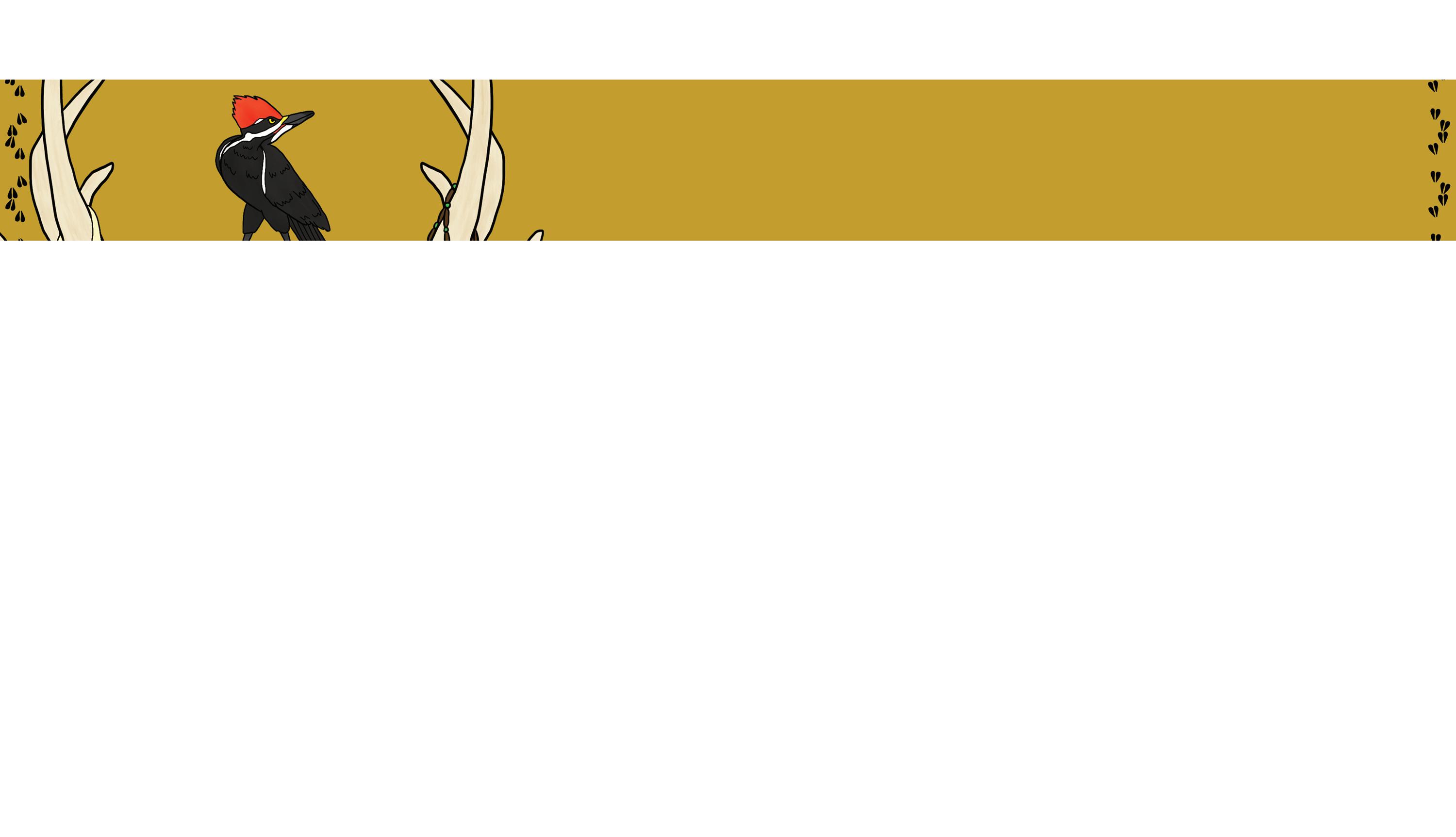


Tómate el tiempo para hablar con ella sobre los peligros del alcohol. Comenzar conversaciones cortas y frecuentes sobre el consumo de alcohol a una edad temprana es el primer paso para mantener a su hijo/a seguro/a e informado/a.

Para obtener consejos sobre cómo y cuándo comenzar la conversación, visita underagedrinking.samhsa.gov.


by Vanessa Saltos
A new chamber of commerce has been officially established in Humboldt County. Joining the 13 other chambers is Cámara de Comercio Humboldt who is working to serve the Latine business community. They are currently laying the groundwork behind the scenes before officially unveiling to the public.
The vision and mission of Cámara de Comercio Humboldt provided by Gino Granados, the chair of Cámara de Comercio Humboldt, is as follows:
Vision: “To strengthen the Latinx business community by fostering partnerships and creating a network of resources that drive economic growth.”
Mission: “Our mission is to uplift Latinx economic prosperity by providing accessible education, resources, robust networking opportunities, strategic partnerships, innovative thinking and advocacy for entrepreneurship and future economic growth.”
Fernando Paz, campus and community development coordinator at Cal Poly Humboldt, said this idea started back in 2022. While organizing Festejando Nuestra Comunidad, Paz said Lucy Salazar, president of Cumbre Humboldt and John Saldana of LatinoNet and himself were talking out loud about what it would look like to have a Latine chamber of commerce for events like this.
With this event, service providers, schools and other segments that serve the Latine community were brought together but the one thing missing was the business connection, said Paz. But creating a Latine chamber wasn’t something Paz felt himself and those involved had the capacity to take on.
“But then we met Gino, and Gino had already been doing the chamber of commerce up in Mckinleyville, and is a business owner, and has some of this experience, and had the capacity to take it on as a project,” Paz said. “So that’s where the idea kind of emerged.”
Granados, part owner of Pupuseria San Miguel, first had the idea a few years ago as well to create something similar for the cannabis industry. It wasn’t until Paz had this conversation with Granados that he saw that Granados was the right person to champion this project.
Paz then connected Granados with Nancy Olson, CEO of the Greater Eureka Chamber of Commerce and Redwood Coast Chamber Foundation. Olson extended her support for the idea and


Paz asked her if she could house the new chamber, said Olson.
“And it was at that moment where everything kind of just clicked at the same time,” Paz said. “Gino was there, the champion to lead it, Nancy was there as a resource to provide leadership and some of the foundational stuff and the community was there.”
Olson agreed and decided to house Cámara de Comercio Humboldt under the Redwood Coast Chamber Foundation.
With many other chambers in the community already Granados was asked why he decided to create a Hispanic chamber. He said it is important to serve and be inclusive of the Latine community.
“When there is not just a language barrier, but a cultural barrier, it is very difficult for an individual to kind of move forward and progress with their business,” Granados said. “And so to have an organization where they can walk into and see people that speak their language, see people that speak their culture, see

people that understand some of the struggles that they've gone through, because those people have gone through it too. It makes a huge change in the success of someone's entrepreneur path.”
In order to support these entrepreneurs, Cámara de Comercio Humboldt plans to offer classes and workshops to their members that will possibly cover topics like marketing, accounting and business planning.
Olson said they are working with the Small Business Development Center to not only help in offering classes but getting more offered in Spanish.
They also hope to host mixers and other events to give businesses the opportunity to network.
Already they have met with the California Hispanic Chambers of Commerce to learn and hear what they offer to their members, said Olson, and plan on reaching out to others to learn from as well.
When it comes to membership details and benefits it hasn’t been officially established but whether you are a part of the Latine community or not, all are
welcome to become a member, said Granados.
Cámara de Comercio Humboldt hopes to partner with other Latine serving organizations and make their first public appearance at the Cinco de Mayo celebration at Jefferson Community Park this year.
Those currently interested in learning more information about Cámara de Comercio Humboldt and becoming a member should contact Olson at nancy@ eurekachamber.com.
Olson said she feels honored from her perspective that members of the Latine community felt they could trust the organization to help support this endeavor.
“That's not something that I take lightly,” Olson said. “It takes a good amount of trust to ask somebody who, I'm not from the Latino community, you know. So this was based on, relationships that I had with Fernando Paz and a little bit with Gino Granados…and I'm really excited about what's ahead.”
by Ryan
Amidst the national shifting of diversity, equity and inclusion practices universities like Cal Poly Humboldt are impacted. As a Hispanic-Serving Institution (HSI), what does the representation of Latine faculty mean as a university, and how does it impact our community?
Every year Cal Poly Humboldt’s Institutional Research, Analytics, and Reporting (IRAR) releases statistics on the demographics of students and faculty. The fall 2024 faculty data revealed that out of 531 faculty, 38 self-identified as Latine. That makes up 7.16% of faculty on campus at this HSI.
Among the 7.16% is assistant professor, Andrea Delgado. Earning her doctorate from the University of Washington, Delgado works in the English department at CPH. She experienced the importance of representation during her time as a student.
While earning her doctorate in comparative literature, cinema and media, Delgado had periods where she almost decided to take a different route because she felt that she didn’t belong.
“When I was in grad school I felt like I didn’t belong. But that all changed for me when I had a Latina professor,” Delgado said. “I was ready to just not go on to the doctorate and just end with my master's until I saw that I had a class with a Latina faculty member who became my mentor in grad school.”
An HSI is a federal designation of public or private colleges or universities that have an enrollment of Pell Grant-eligible undergraduate full-time students totaling at least 25%.
With the HSI designation only technically coming from the number of Latine students, Delgado said, there needs to be more improvement in this area. It is about actually serving those students and going beyond just wearing the HSI as a badge, said Delgado.
In the current political climate, there has been a rise in resistance to diversity, equity and inclusion (DEI) practices in and out of universities which begs the question of how the university will proceed.
“More than ever this is an important

time for us to be brave as an institution. Instead of moving away from some of the policies that we fought so hard to establish, we should move in full force including becoming a sanctuary institution,” Delgado said.
Catalina Alexander is a Freshman at Cal Poly Humboldt majoring in environmental studies. As a Latine student, Alexander feels she has not felt well represented due to not seeing many Latine professors.
“I have only had one Latinx professor and it was for my Chicano history class,” Alexander said. “It impacted the class well, I felt heard and seen. It would have been weird if my professor was not Latinx. It feels good to me when I see faculty members that look like me. I have always had majority white teachers.”
Fernando Paz, campus and community development coordinator at the office of diversity, equity and inclusion (ODEI) serves as a public-facing liaison between the office and on and off-campus communities. ODEI has a goal of moving from checking a box for compliance to holistic changes.
“Moving beyond check the box compliance focused efforts to holistic changes in campus culture and daily
interactions. We are involved in leading a number of institutional initiatives,” Paz said.
Paz highlights the programs on campus that support Latine students academically and socially.
“There are a number of programs and initiatives across campus to support Latinx students in many ways including academically and socially,” Paz said. “Primary among them is El Centro Académico Cultural de Humboldt which includes a culturally responsive
academic advisor and a number of events for socializing throughout the academic year, ‘Cafe con Chisme’ being one of the most successful of these events.”
Delgado offers a piece of advice for students for their success.
“Find your people in terms of students and faculty, who you feel comfortable asking questions. Don’t be afraid to ask questions,” Delgado said.
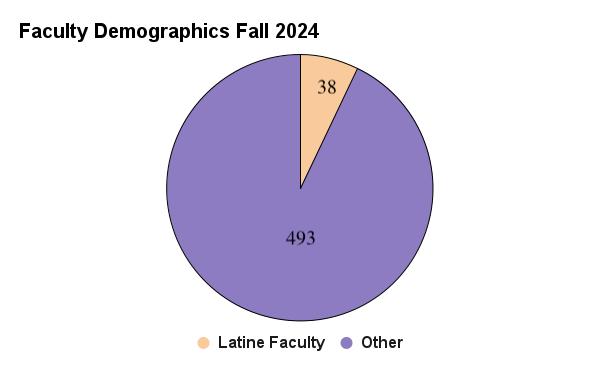













13 DE ENERO AL 30 DE ABRIL PRINCIPIANTE A INTERMEDIO
707-443-5021


CLASES DE IDIOMA INGLÈS CLASES DE CIUDADANÍA English Express
EN LÍNEA
Los martes y jueves, 6:30 - 7:30 p.m.
Zoom ID 707-443-5021
Contraseña 464816
EN PERSONA
EUREKA
Los miércoles, 6:30 - 7:30 p.m.
Jefferson Community Center
Sala 2, 1000 B Street
FORTUNA
Los jueves, 11:30 a. m. - 12:30 p. m.
Iglesia Episcopal St. Francis
Salón comunitario, 568 16th Street
RIO DELL
Los sábados, 11:30 a.m. - 12:30 p.m.
Centro de recursos comunitarios de Rio Dell, 406 Wildwood Drive







EnglishExpressEmpowered.com
EN PERSONA
Preparación para el examen de naturalización
EUREKA
Los lunes, 6:00 - 7:00 p.m.
Jefferson Community Center
Sala 2, 1000 B Street
FORTUNA
Los martes, 11:30 a. m. - 12:30 p. m.
Iglesia Episcopal St. Francis
Ferguson House 568 16th Street







Love and support fosters a creative mind
by Henry Lagunas
Izzy Starr, the owner of Dope Soul Studios, makes stunningly colorful keychains and stickers that are available online on her Etsy store. Every piece is cute, playful and contains so much detail, an indication of the love and effort Starr puts into her art.
Born and raised in Tracy, California, Starr has been playing softball competitively since she was 10 years old and as a senior in high school she committed to Humboldt State, now known as Cal Poly Humboldt. She moved to Humboldt in 2019, and has been here ever since.
“I fell in love with Humboldt before I even got here,” Starr said.
Starr played softball throughout college and graduated with her bachelor’s degree in film in May 2024. She is currently working in Arcata while also making plenty of time to focus on her creative process. She relies on her roots and strong relationships to keep her motivated with her art.
“Something that inspires me is definitely my parents. My mom and my dad are super hard working people,” Starr said. “They’ve pushed me alot and they’ve always been accepting and excited about all the new stuff and art that I have for them.”
Starr shared how her brother encouraged her to follow her passions.
“I remember having a conversion actually with my brother that got to an emotional point where, when I was here at college, I wasn’t studying what I wanted to because I was scared that I wasn’t gonna really make an impact or be successful,” Starr said. “He’s younger than me and it hit really hard when he got emotional that he realized I wasn’t doing what I loved to do and what I wanted to do and I wasn't pursuing it as much as I could.”
For Starr, her journey with art began when she was very young, as her parents and grandmother were into arts and crafts. Her family bought her many books and art supplies as she grew up. Her mother is also a photographer who has a deep love for art and Starr receives plenty of artistic and creative influence from her family members. In addition
to making keychains, Starr also loves to paint, draw, watercolor and make digital art.
Another person that Starr credits with supporting her artistic journey is her boyfriend. Starr recalled the heartwarming memory of when he got her an iPad for Christmas a couple years ago, allowing her to further pursue her creative passions. His support and encouragement pushed Starr out of her creative comfort zone and allowed her to challenge herself. She believes that this process has helped her build on her skills and grow as an artist.
“It was another person who believed in me no matter what,” Starr said. “He’s always excited to see what art I have. He’s always interested in what I'm working on, and I always feel comfortable asking him what I should draw.”
For now, Starr wants to get her art out into the community and is interested in meeting new people. She has been able to have the experience of being a vendor at a couple of art markets. Having that dynamic of meeting other artists has created an environment of collaboration and affirmation.
“Every single artist that I interacted with was super accepting and super nice,” Starr said. “It’s inspirational and it keeps me motivated.”
You can follow Starr on Instagram @dopesoulstudios.



El amor y el apoyo fomentan una mente creativa
Escrito y traducido por Henry Lagunas


Izzy Starr, propietaria de Dope Soul Studios, crea llaveros y stickers increíblemente colorados que están disponibles en línea en su tienda de Etsy. Cada pieza es adorable, divertida y con muchísimos detalles, una muestra del amor y el esfuerzo que Starr pone en su arte.
Nacida y criada en Tracy, California, Starr ha jugado sofbol de forma competitiva desde los 10 años y se comprometió con Humboldt State en el último año de secundaria. Se mudó a Humboldt en 2019 y ha estado aquí desde entonces.
"Me enamoré de Humboldt incluso antes de llegar", dijo Starr.
Starr jugó sofbol durante toda la universidad y se graduó con su licenciatura en cine en mayo de 2024. Actualmente trabaja en Arcata, a la vez que dedica mucho tiempo a su proceso creativo. Se basa en sus raíces para mantenerse motivada con su arte. Sus sólidas relaciones la inspiran a seguir creando.
“Algo que me inspira sin duda son mis padres. Mi mamá y mi papá son personas muy trabajadoras”, dijo Starr. “Me han impulsado mucho y siempre han aceptado y se han entusiasmado con todas las cosas nuevas y el arte que les tengo para ofrecer”.
Starr compartió cómo su hermano la animó a seguir sus pasiones.
“Recuerdo haber tenido una conversación con mi hermano que llegó a un punto emotivo. Cuando estaba aquí en la universidad, no estudiaba lo que quería porque tenía miedo de no tener un impacto real ni éxito”, dijo Starr.
“Él es más joven que yo y fue muy duro para él darse cuenta de que no estaba haciendo lo que me encantaba y lo que quería, y que no lo estaba persiguiendo tanto como podía. Ese fue un punto clave para mí, donde comprendí que mi familia me apoyará, haga lo que haga, y que siempre me querrán”.
Para Starr, su aventura artística comenzó desde muy pequeña, ya que sus padres y su abuela eran muy aficionados a las artes y oficios. Su familia le compró varios libros y materiales de arte mientras iba creciendo. Me dejó saber que su madre es una fotógrafa que tiene mucho amor al arte. Recibe mucha influencia artística y creativa de
su familia. Además de hacer llaveros, a Starr también le encanta pintar, dibujar, pintar con acuarela y crear arte digital.
Otra persona a la que Starr atribuye el apoyo en su trayectoria artística es su novio. Starr recordó el momento conmovedor en que le regaló un iPad por Navidad hace un par de años, lo que le permitió seguir cultivando sus pasiones creativas. Su apoyo y ánimo la impulsaron a salir de su zona de confort creativa y le permitieron retarse a sí misma. Afirma que este proceso la ha ayudado a desarrollar sus habilidades y a crecer como artista.
"Era otra persona que creía en mí, pase lo que pase", dijo Starr. "Siempre le entusiasma ver mis obras. Siempre le interesa lo que estoy haciendo, y siempre me siento cómoda preguntándole qué debería dibujar".
Por ahora, Starr quiere compartir su arte con la comunidad y le interesa conocer gente nueva. Ha tenido la experiencia de ser vendedora en un par de mercados de arte. Siente que esa dinámica de conocer a otros artistas ha creado un ambiente de colaboración y afirmación.
“Todos los artistas con los que interactúe fueron muy receptivos y amables”, dijo Starr. “Es inspirador y me mantiene motivada”.
Puedes seguir a Starr en Instagram @dopesoulstudios.

Para el vídeo escanear el código QR
by Kimberly Alexsandra Madrigal
If you’re someone who is scared of commitment but is equally as nosey, in regards to tattoos, you probably ask others all about them when you see one peeking out.
I love a little goofy spongebob dorm room stick and poke but I also love when I see a literal piece of art, sketched into a limb, especially when they are culturally significant. I sourced each person in this article based on looks, literally, and this is what I got…
Kyle Sabio, is a sociology transfer student at Cal Poly Humboldt originally from Ventura county. His first and only tattoo is a full Polynesian tribal sleeve tattoo on his right arm that took around 20 hours to complete. This was a gift to himself for turning 21 and graduating from community college.
Sabio’s tattoo is heavily influenced by his Filipino heritage, with its main focus being family values and strength. He was even tattooed by the same artist who has done pieces for his father as well.
“Bamboo is for family, the spearheads I have [represent] strength, any triangle, symbolizes shark teeth, is power,” Sabio said.
His sleeve also includes tropical leaves, diamonds and tiki head outlines that symbolize protection.
With his unique mosaic, he pays homage to his main tatted influence, his father, with one specific portion of his sleeve.
“I have the Filipino sun on my shoulder and it has my last name,” Sabio said.
Sabio’s father has the same piece on the back of his calf. Their last name Sabio, is written in Alibata, an ancient pre-Hispanic Filipino script.
“I thought it was cool, he has the same thing, and (now) I have it on my arm,” shared Sabio.
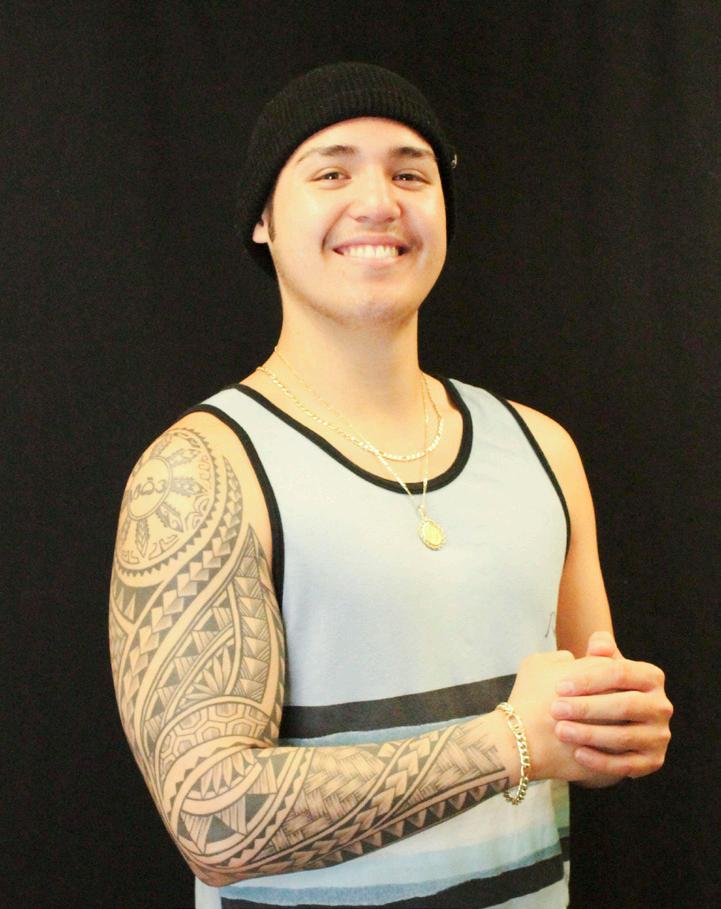
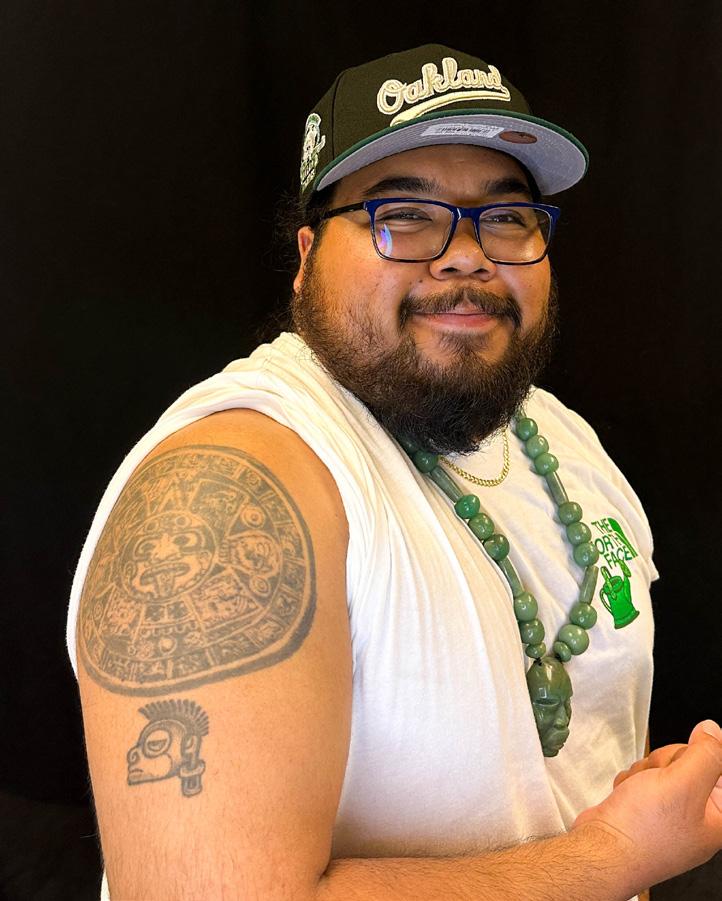

Dabid Garcia is a Graduate student and student assistant at COMPASS (formally known as INRSEP) has only one seriously iconic tattoo. He has a finely detailed necklace piece that wraps around his chest, shoulders and back. Garcia shared that this piece is the second ring of the Aztec calendar, made up of 20 symbols of the named days contained within a month.
“I have both Mexica and Purepecha ancestry so I wanted a piece that connects me to my roots,” Garcia said. “I chose the Aztec calendar for its ancient cultural significance, its beauty, and to remind me of the passage of time. I chose the placement around my neck to leave out the depiction of the sun god, Tonatiuh, to represent my atheism and self determination.”
Garcia shared that his late brother-in-law and him had always talked about tattoos. But it wasn’t until his passing, Garcia felt inspired to make the effort of researching and eventually getting a tattoo in his honor.
Dabid explains that following the completion of his tattoo he didn't feel like a new person, but rather a changed one.
“As painful as it was to get it done, I proved to myself that I was capable of powering through the pain of it all,” Garcia said.
Garcia plans on adding more to his collection, while highlighting another vital part of his life which is botany.
“I do plan on getting more pieces done in the future. I really want to get some botanical pieces done as plants are a central part of my life,” Garcia said.
Frank Cortes, also known as Chicome Malinalli, is a junior geography major from Oakland. When Cortes was 16, he, his mother and uncle all got tattooed by the same artist on the same day at an Indigenous ceremony.
On the top of Cortes' right shoulder lies the detailed and complex ancient Aztec calendar called Tonalamatl in the language Nahuatl.
“The Mexica people (created) this calendar to mark the relationships between humans and the natural world, we thought we were together, like one.”
“I decided to get this piece because of what it means, I needed something that I could look at any point of my life, it represents time, I guess it's like
a timeless piece for me i feel like when im older, i'll look at it and it'll have a different meaning then, but right now it helps me to see how far we’ve come.”
Just under the calendar is another tattoo Cortes received at 21. It’s a monkey deity representing and honoring the era on the calendar Cortes’ mother was born under. She has the same for him on her arm.
“Would [his parents] let me get my last name, my moms name or moms face? No, Cortes laughed. “But like anything cultural, yes.”
Cortes shared his plans to continue this “collection” as he is dedicating his whole right arm solely to cultural tattoos. He also has plans of getting the Aztec goddess, Coatlicue on his back once he graduates from CPH. She represents mother earth and the duality between masculine and feminine energies.
“My parents are huge advocates of anything that has to do with culture, anything I could back up through research, or oral or written history, anything to keep the culture alive,” Cortes said. “They're like yeah go for it.”
by Henry Lagunas
South Korean film director Bong Joon Ho is running out of ways to tell us to not trust this system of capitalism we are currently living under.
His first English language Hollywood co-productions, “Snowpiercer” and “Ojka,” also explore class struggle and corporate greed. In 2019, Bong Joon Ho was able to release his masterpiece, “Parasite”, which won four major awards at the 92nd Academy Awards, including Best Picture. This film touches on class solidarity, wealth disparity, colonialism and imperialism.
“Mickey 17” is a continuation of the ideas Bong Joon Ho has been exploring for his entire artistic career. Robert Pattinson plays Mickey Barnes, an ‘expendable’ who is able to come back from death by being replicated with a human printer.
Mickey is not an intelligent person, and he is constantly being taken advantage of throughout the film. He joins an expedition to colonize an ice planet known as Niflheim, however, he does not know what he is signing up for and is really just looking for an escape.
He goes to this large corporate building filled with other desperate
people who are also trying to get their paperwork in to escape their specific situations. I felt that this part of the movie directly referenced our global refugee crisis and particularly U.S. immigration policy. The camera pans up to show a seemingly never ending spiral staircase filled with people waiting in line to turn in their paperwork.
Some people might be put off by Bong Joon Ho’s disillusionment towards our modern day politics and capitalism, but movies like this are more important now than ever. Especially with mainstream media and major production companies bowing down towards the fascist and authoritarian tendencies of Donald Trump’s current administration.

Mark Ruffalo plays Kenneth Marshall, a failed politician with a cult-like following that has speech patterns reminiscent of Trump, Elon Musk and a little bit of RFK Jr. He is the leader of this expedition, along with his wife Ylfa, played by Toni Collette. Together they play a couple that has very little regard for the other people aboard the ship. Their only goal is to fulfill their legacy and conquer this new world by any means necessary. This new world has tardigrade-like lifeforms which they refer to as ‘creepers.’ An allusion to the flippant attitude colonizing forces have towards Native inhabitants.
Pattinson reinvents himself many times throughout the movie, and does a stunning job employing a weird accent along with a quiet physicality to embody this hopeful tortured soul of Mickey Barnes.
The writing is sharp and darkly humorous, and I was blown away with how accurate it is in terms of skewering the ineptness of our government leadership in the United States. There is an idealistic quality that made me hopeful, and I found the morbid comedy amusing.
Escrito y traducido por Henry Lagunas
El director de cine surcoreano Bong Joon Ho se está quedando sin palabras para decirnos que no confiemos en el sistema capitalista en el que vivimos.
Sus primeras coproducciones en inglés con Hollywood, “Snowpiercer” y “Ojka”, también exploran la lucha de clases y la avaricia corporativa. En 2019, Bong Joon Ho estrenó su obra maestra, “Parasite”, que ganó cuatro premios importantes en la 92.ª edición de los Premios Óscar, incluyendo el de Mejor Película. Esta película aborda la solidaridad de clase, la desigualdad de la riqueza, el colonialismo y el imperialismo.
“Mickey 17” es una continuación de las ideas que Bong Joon Ho ha explorado a lo largo de toda su carrera artística. Robert Pattinson interpreta a Mickey Barnes, un "reemplazable" que puede resucitar de la muerte al ser
replicado con una impresora humana.
Mickey no es una persona inteligente y se aprovechan de él constantemente a lo largo de la película. Se une a una expedición para colonizar un planeta helado conocido como Niflheim; sin embargo, no sabe a qué se está metiendo y, en realidad, solo busca una vía de escape.
Se dirige a un gran edificio corporativo lleno de otras personas desesperadas que también intentan organizar sus documentos para escapar de sus situaciones específicas. Sentí que esta parte de la película hacía referencia directa a nuestra crisis mundial de refugiados y, en particular, a la política de inmigración estadounidense. La cámara se desplaza hacia arriba para mostrar una escalera aparentemente interminable llena de gente haciendo fila para entregar sus documentos.
A algunos les puede desagradar la desilusión de Bong Joon Ho con la política y el capitalismo modernos, pero películas como esta son más importantes ahora que nunca. Especialmente con los grandes medios de comunicación y las grandes productoras cediendo ante las tendencias fascistas y autoritarias de la actual administración de Donald Trump. Mark Ruffalo interpreta a Kenneth Marshall, un político fracasado con una clientela casi de culto. Habla como una combinación a Trump, Elon Musk y un poco a RFK Jr. Él es el líder de esta expedición, junto con su esposa Ylfa, interpretada por Toni Collette. Juntos interpretan a una pareja que tiene muy poco respeto por las demás personas a bordo de la nave espacial. Su único objetivo es cumplir su legado y conquistar este
nuevo mundo cueste lo que cueste. Este nuevo mundo alberga formas de vida similares a tardígrados, a las que llaman "creepers", una alusión a la actitud frívola de las fuerzas colonizadoras hacia los habitantes nativos.
Pattinson se reinventa a sí mismo muchas veces a lo largo de la película y hace un trabajo impresionante empleando un acento extraño junto con una fisicalidad discreta para encarnar esta alma esperanzada y torturada de Mickey Barnes. El diálogo es fuerte y de humor oscuro, y me impresionó su precisión al criticar la ineptitud de nuestros líderes gubernamentales. Hay una cualidad idealista que me hizo tener esperanza, y encontré la comedia morbosa divertida.
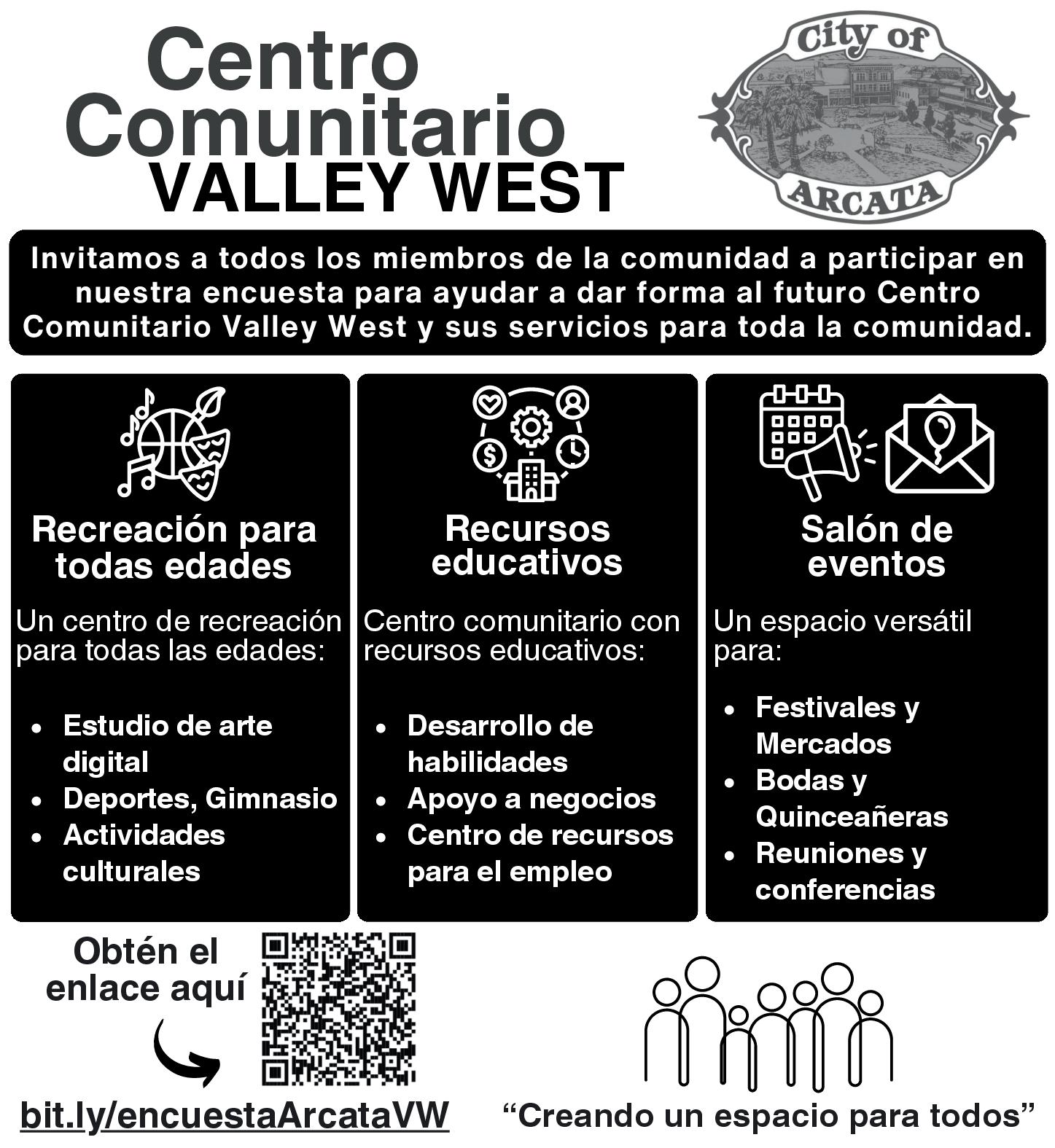






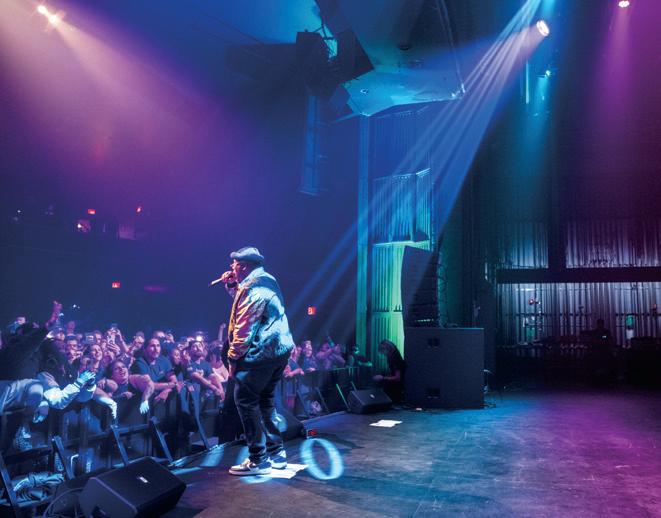

New Book Honors Humboldt’s Bilingual Portuguese Heritage Finishing Line Press presents
A story/poem of love and hope.
On her daily walks, struggling with the limitations of her aging body, Mrs. Silva becomes the immigrant spirit of the Azores, and of America. Her courage to endure reflects the heroism of women everywhere. With inspiring dignity, Mrs. Silva’s personal journey to the end of the lane becomes a passage to the edge of history. Bruna Dantas Lobato’s beautiful Portuguese translation connects Mrs. Silva Walks to the Azores, with the NorCal Portuguese community, and with the struggles of immigrant women throughout the Portuguese-speaking world.
Order before April 4 for 20% off




Local Indigenous woman designs and sells woven jewelry by
Joahnna Tool
A dynamic connection to the earth, fire and water shapes Kin-sin-ta’ Joseph’s lifestyle and artistry as she creates jewelry pieces inspired by her cultural traditions.
Joseph is an Indigenous woman who is Hupa and Karuk on her maternal side and Nüümü and Newe (Paiute and Shoshone) on her paternal side. She is from the Hupa villages of Me’dilding and Tse’wenaldin.
She first learned to weave at around 11 years old, where she was originally taught by her older cousin in preparation for her Xo q’it Ts’is waal (on her, he or she keeps time), a coming of age ceremony practiced by Hupa women, also known as the Flower Dance.
This cultural tradition includes women’s talking circles, training, fasting and learning prayer songs, which lasts 10 days. Joseph spent time isolated as she learned to weave her dress used in the ceremony.
In 2016, Joseph went to the Standing Rock protests in North Dakota, a series of Native American protests showing solidarity for the Standing Rock Sioux Tribe in opposition against the construction of the Dakota Access Pipeline. She set up “California Kitchen” as a way to help feed the camps, following calls to protect Native youth and water. That is where she first fell in love with gifting others a piece of her ancestors, especially in different Native spaces. She found making jewelry is another way for her to share a part of her culture.
Then, in 2017, she created a website for her small jewelry business called Payahupaway. The name is inspired by the word “Payahupawei” from the Nüümü language, which means where the water flows. This name encompasses aspects of the place where her father comes from, Payahuunadü, the land of the flowing water, as well as the name of her maternal community, Hupa.
Starting Payahupaway helped Joseph assert herself as a creative artist. Her art is inspired by traditional materials that her ancestors originally used in their regalia and baskets. She finds herself braiding all the time, while she’s traveling on the road, watching movies and even while supposedly resting.
“Beargrass is my signature, there are
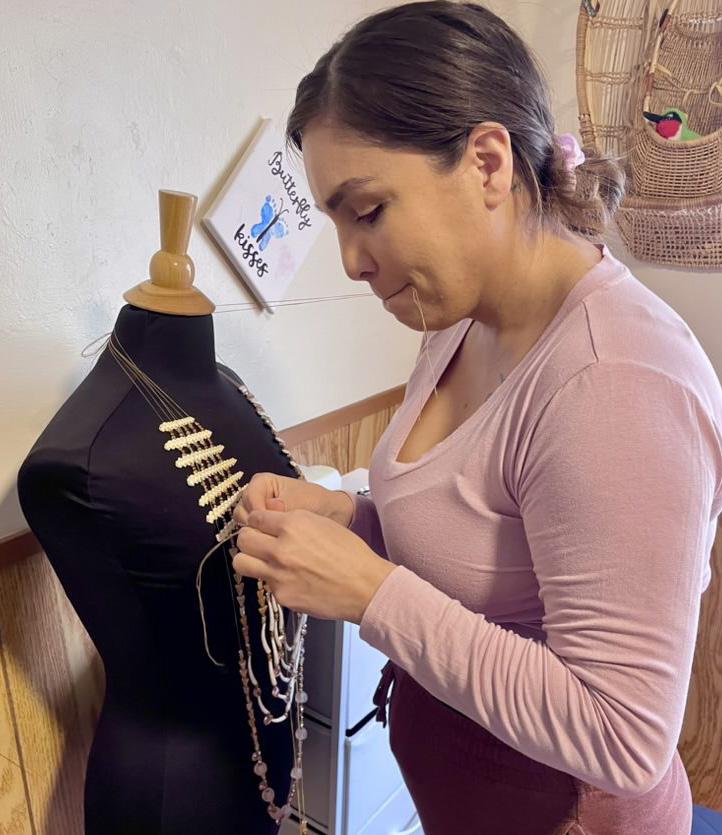
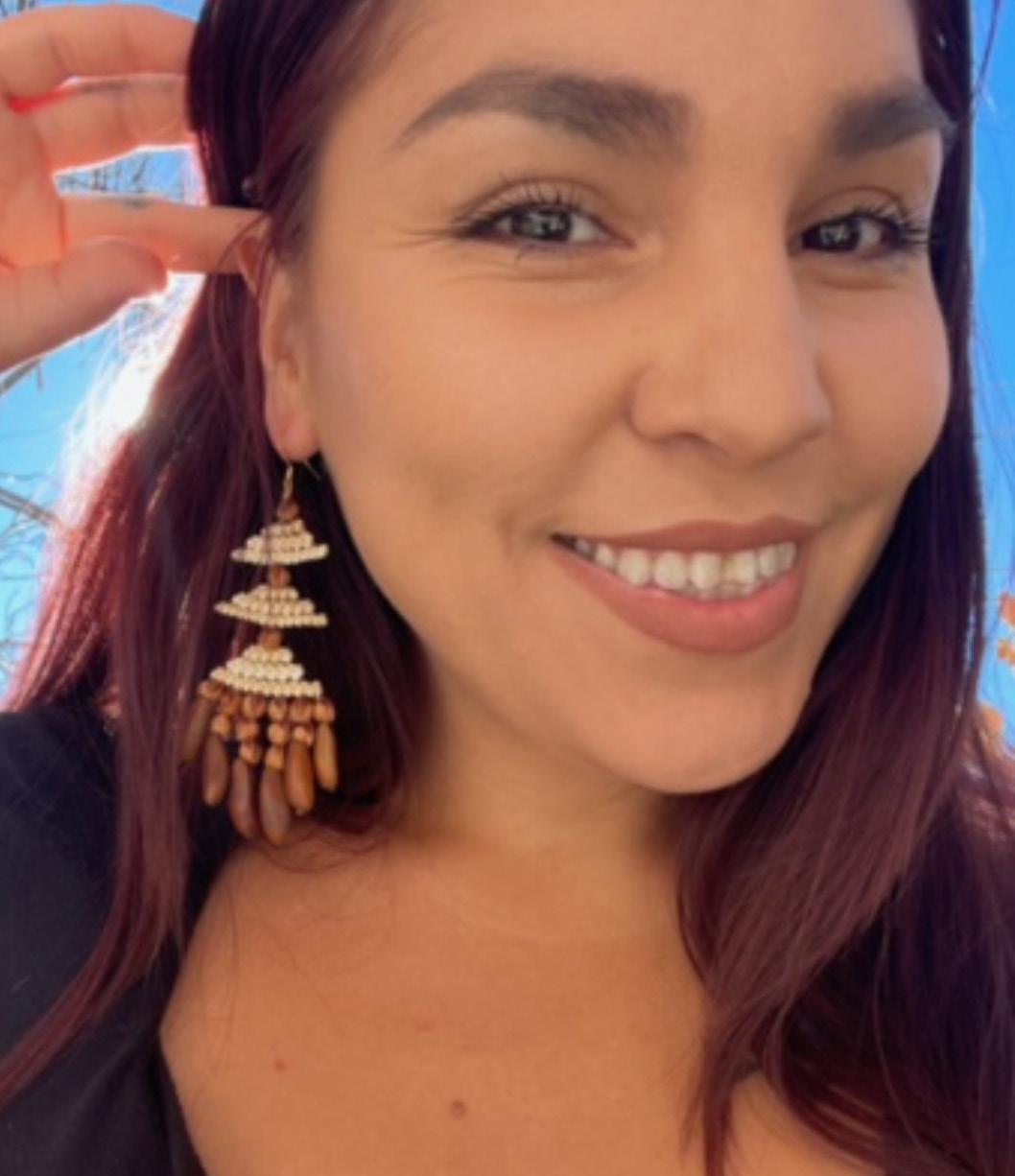

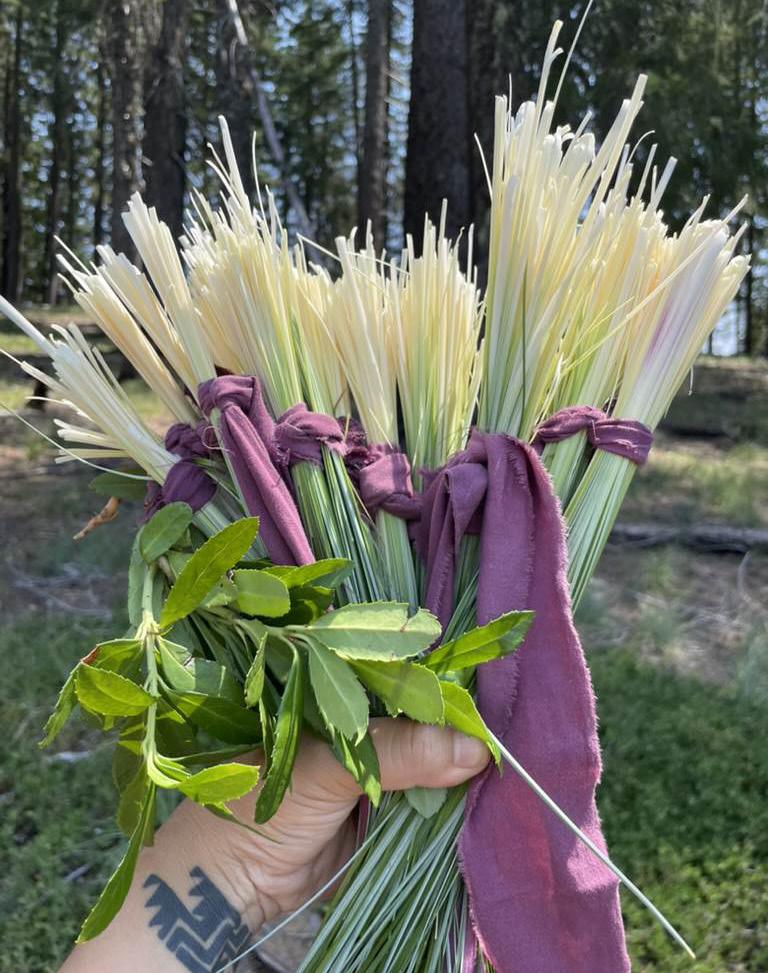
2. Kin-sin-ta’ Joseph shows off her handmade earrings for her small business, Payahupaway.
3. Earrings made by Kin-sin-ta’ Joseph for her small business, Payahupaway, using beargrass and acorns. Photo provided by Joseph.
4 Kin-sin-ta’ Joseph holding bundles of beargrass after having collected them. Photo provided by Joseph.
many different ways of weaving her,” Joseph said. “She helped structure my life in a way–I can’t imagine my life without her.”
Her first encounter with beargrass was at her auntie’s house, who is a well known regalia maker. Joseph’s aunties and cousins would often tell her that she flows well with the beargrass.
Joseph believes working with beargrass is not something you can force. It is important to have sturdy yet gentle hands. According to her, beargrass has a motherly spirit and should be cared for
in the same way you would treat a relative. The grass is typically gathered in the late summer after a cultural burn and collecting it is essential to the well being of the land, the animals and the people.
The typical process for creating jewelry includes gathering the beargrass, letting it dry out and then choosing out pairs and putting them to soak. Afterwards, Joseph has braiding and assortment days where she actually puts the pieces together.
“I let the materials talk to me. Sometimes [ideas] come to me in dreams or
early morning thoughts, seeing different patterns,” Joseph said.“Native art has evolved throughout the years and I am inspired by other artists.”
The oral traditions that Joseph grew up with say that whatever one creates has life. She believes the creations hold an energy based on what is invested in them, and emphasizes the importance of recognizing the difference between pieces made specifically for ceremony and jewelry made for everyday wear. All the more so because she does not want to be portrayed as selling regalia.
While she was taught to put good energy into her work, she has learned through personal circumstances that it's not always that.
“It’s a spectrum, me and her [beargrass] are figuring it out together,” Joseph said.“This lifestyle has prepared me for difficult moments.”
Joseph described herself as being in a transition period in which she has been trying to find a balance between making art and making a living. She wants to be very intentional about who is buying her art and their reasons behind it, especially because it can be very hard to let go of certain pieces who she considers friends.
“Being aware of the material, where it comes from, how it’s processed, knowing about cultural burns. When [people] know about that it uplifts tribal sovereignty,” Joseph said.
In addition to creating art, Joseph is a mother to twin boys and one daughter, who she is currently teaching how to weave. She has hopes for her sons to participate in cultural burns and the material collecting process once they’re older.
Jewelry pieces made by Kin-sin-ta’ Joseph for Payahupaway can be found for sale on her website https://payahupaway.com/ and in person at La Ciendita in Arcata.
“She’s been very open to being an artist at the shop,” Octavio Acosta, owner of La Ciendita said. “It’s been meaningful to have a relationship with her and to have a space where our two respective cultures can exist with respect and mutual benefit. Especially because we are a local Latino and Indigenous boutique representing art and community.”

El Comité de Prevención de Agresiones Sexuales (SAP C) de Cal Poly Humboldt tiene una colección de recursos para ayuda r a quienes enfrentan las siguientes situaciones: abuso de imágenes, ciberacoso, extorsión, chantaje, discursos de odio en línea, doxxing y otr as situaciones más.
Escanea el código QR a continuación para conectarte y obtener más información. Próximamente en español.
Te invitamos a seguir explorando muchas más opcione s de apoyo:
Guía de Recursos sobre Violencia de Género Basada e n Tecnología c reada y mantenida por SAPC de Cal Poly Humboldt.
Si estas en los condados de Humboldt o Del Norte, te recomendamos contactar primero con The Campus Advocate Team (CAT). CAT está compuesto por defensores del North Coast Rape Crisis Team, quienes pueden proporcionar apoyo y servicios GRATUITOS Y CONFIDENCIALES a estudiantes, profesores y empleados de Cal Poly Humboldt, sin importar su identidad de género, que hayan sido afectados por agresión sexual, violencia en el noviazgo o doméstica, acoso y/o acoso sexual.
Teléfono: (707) 445-2881 (Disponibles 24/7)
Texto: (707) 382-5174 (L-V, 8:30 a.m. - 4:30 p.m.)
* "La diferenciación entre la vida real y la vida digital hace que las personas crean que el daño causado en línea es menos grave que la violencia cometida en el mundo físico". https://vita-activa.org/2021/10/26/la-vida-digital-es-vida-real/
by Ryndi Greenwell
Robert F. Kennedy Jr. is now the United States Secretary of Health and Human Services after being appointed to his position by President Donald J.Trump last November. Since beginning this role, I have been horrified by his obvious lack of knowledge surrounding any topic involving medicine or health. His most recent push to ‘Make America Healthy Again’ was a proposition to disinclude “junk food” from the Supplemental Nutrition Assistance Program (SNAP).
“There, the federal government in many cases is paying for it [SNAP]. And we shouldn’t be subsidizing people to eat poison,” Kennedy said in an interview with FOX news in February 2025. I would like to remind everyone that someone who hit a bear with his car and put it in Central Park believes he knows what is best for America’s health. Kennedy has also claimed that vaccines cause autism, despite nearly every medical professional in the world strongly discrediting this conspiracy theory.
Not to mention one his most dangerous initiatives—loosening federal regulations on the distribution and sale
of raw milk. Consuming raw milk has recently become popular due to the strange belief that it is “unprocessed” and therefore “better for you.” According to the Centers for Disease Control and Prevention, raw milk is actually considered extremely susceptible to food borne illnesses such as salmonella, listeria, E.Coli and more.
Kennedy has clearly demonstrated that his level of medical knowledge is non-existent. Now he has suggestions on how to restrict low-income people even more? Individuals and families alike struggle to survive on SNAP benefits in this declining economy already. Why take away their choice of what to purchase and eat? Besides buying groceries for purely nutritional or survival purposes, food has more value beyond that. People deserve a nice cake on their birthday or a bag of chips to satisfy their salty cravings, just like people who can afford groceries without assistance.
On top of that, how exactly would a SNAP “junk food ban” even work? What is considered junk differs from person to person, and not everyone has
the same dietary requirements. When it comes to kids, we have all known a child that will not eat unless it is something simple, beige and recognizable. To some, this is an unhealthy meal. However, just getting someone who has food aversions to eat something is winning. When it comes to vague, subjective terms like “unhealthy” or “processed”
there is too much variability and nuance. It feels as though Kennedy is targeting the poor by directly restricting the very personal freedom of choosing what we eat.
*This only reflects the opinion of the author, not of the newspaper as a whole.

Escrito por Ryndi Greenwell y traducido por Joahnna Tool
Robert F. Kennedy Jr. ahora es el Secretario de Salud y Servicios Humanos de los Estados Unidos después de ser designado por el presidente Donald J. Trump el pasado noviembre. Desde que comenzó este papel, yo he estado aterrorizada por su obvia falta de conocimiento sobre cualquier tema involucrando la medicina o salud. Su esfuerzo más reciente para ‘hacer América saludable de nuevo’ fue una propuesta para no incluir “comida chatarra” en el Programa de Asistencia Suplementaria (SNAP por sus siglas en inglés).
“Ahí, el gobierno federal en muchos casos está pagando por ello [SNAP]. Y no deberíamos estar subvencionando para que la gente coma veneno,” Kennedy dijo en una entrevista con las noticias FOX en Febrero de 2025.
Me gustaría recordarle a todos que
alguien quien atropelló a un oso con su carro y lo puso en el Parque Central cree que él sabe lo que es lo mejor para la salud de América. Kennedy también ha afirmado que las vacunas causan autismo, a pesar de que casi todos los profesionales médicos del mundo desacreditan firmemente esta teoría conspirativa.
Sin mencionar unas de sus iniciativas más peligrosas- flexibilizar las regulaciones federales sobre la distribución y venta de leche cruda. El consumo de leche cruda se ha vuelto popular recientemente debido a la extraña creencia de que “no está procesada” y, por lo tanto, es “mejor para ti.” Según la Centros para el Control y la Prevención de Enfermedades (CDC), la leche cruda es considerada extremadamente susceptible a enfermedades transmitidas por
alimentos como salmonella, listeria, E. coli y más.
Kennedy ha claramente demostrado que su nivel de conocimiento médico es inexistente. ¿Y ahora tiene sugerencias sobre cómo restringir aún más a las personas de bajos ingresos? Tanto las personas como las familias luchan por sobrevivir con los beneficios del SNAP en esta economía en declive. ¿Ahora quiere quitarles sus decisiones de qué comprar y comer? A pesar de comprar alimentos con fines puramente nutricionales o de supervivencia, la comida tiene más valor que eso. La gente merece un buen pastel en su cumpleaños o una bolsa de papas fritas para satisfacer sus antojos salados, al igual que las personas que pueden comprar alimentos sin ayuda.
Además de eso, ¿como funciona-
ria exactamente una “prohibición de comida chatarra” del SNAP? Lo que se considera chucherías varía de persona a persona y no todos tienen los mismos requisitos dietéticos. Cuando viene a los niños, todos conocemos a alguno que no come a menos que sea algo plano y reconocible. Para algunos, esta es una comida poco saludable. Sin embargo, simplemente conseguir que alguien que tiene aversión a la comida como algo es un triunfo. Cuando se trata de términos vagos y subjetivos como “poco saludable” o “procesado,” hay demasiada variabilidad y matices. Parece como si Kennedy se dirigiera a los pobres al restringir directamente la libertad personal de elegir lo que comemos.
* Esto refleja únicamente la opinión del autor, no del periódico en su conjunto.

2025 ASSOCIATED COLLEGIATE PRESS
SPRING NATIONAL COLLEGE MEDIA CONFERENCE
FIFTH PLACE WEBSITE
FIFTH PLACE NEWSPAPER
2025 CALIFORNIA COLLEGE MEDIA ASSOCIATION AWARDS
FIRST PLACE
Best Spanish-Language Coverage Staff
Best Photo Series
Ben Hernandez, Peyton Leone, Jacqueline V. Espinoza

Meet the New Crew at El Centro!
Find Your Community in Humboldt – We’re Here for You!
Join us for Fridays de Chisme!
El Centro Nelson Hall East 205 Fridays, 2-3 PM
Want to be part of something big?
Volunteer at El Centro Graduation!
We can’t wait to meet you!
Best Newspaper Front Page Design
Maryanne Casas-Perez
Best Headline Portfolio
Ben Hernandez
SECOND PLACE THIRD PLACE
Best Newspaper — Staff
Best Special Issue/Section — Staff
Best Multimedia Package Lila Salinas
WE NEED:
WRITERS • COPY EDITORS

TRANSLATORS •PHOTOGRAPHERS
VIDEOGRAPHERS • ARTISTS
GRAPHIC DESIGNERS • SOCIAL
MEDIA • PR • WEBSITE TECH
REGISTER JMC 160 - FALL 2025
2 UNITS - CR/NC • MW 4-6 PM
OPEN TO ALL MAJORS NO EXPERIENCE REQ.
SPANISH NOT A REQUIREMENT PRE-REQ CAN BE WAIVED


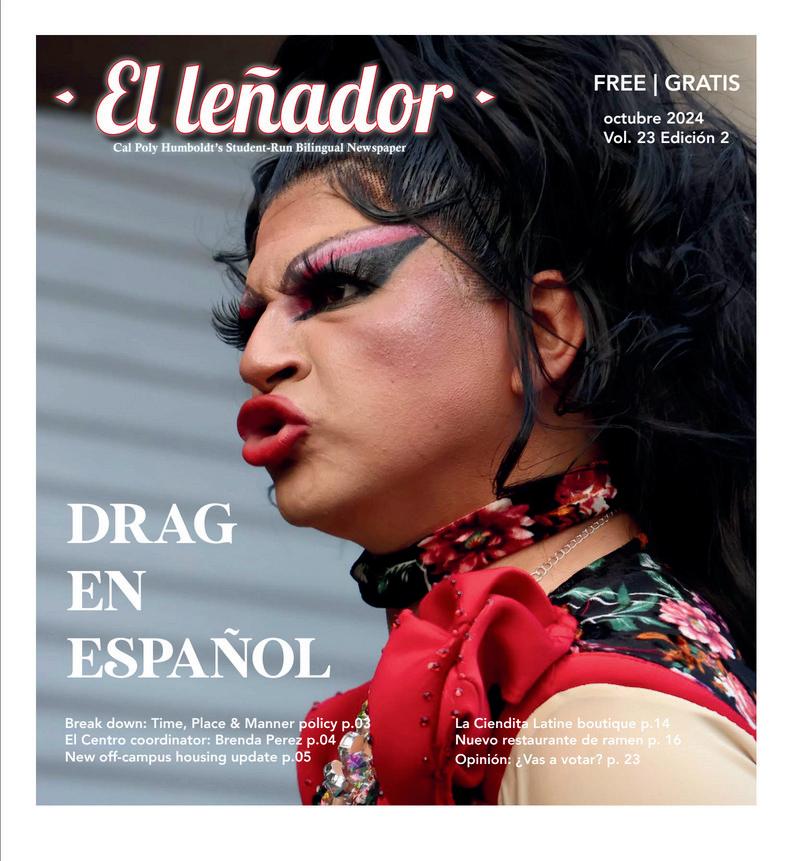

Ciencia con Chisme: 4/4 & 5/2
Café con Chisme & Pan Dulce: 4/11 & 4/25





Must meet minimum qualifications Must be committed to attending meetings Must uphold responsibilities as assigned
by Alba Guadalupe Galvan
As a 19-year-old college student with depression, let me just say it sucks. It's hard to make friends, stay motivated and it's also hard being away from your family. It's hard when you have so much homework, you get stressed or your major is super small and the classes you take all have gaps in between so now your whole day is gone because of school. It's hard to adapt at first.
I went from having my own room and hiding whenever I didn't want to face the world— the place where I can be sad, happy, stressed and numb— to having to share a dorm suite with three other roommates. It's a big change, especially for a freshman like myself, who is gaining all these new experiences for the first time. It can be hard.
I have depression. I've known that for a good five years now. It used to be worse and because I was home-schooled in high school that allowed me to be self-destructive. I would stay cooped up in my room all day just in silence and it would get so bad I wouldn't leave my room unless I had to get food or use the bathroom. I would go weeks without showering and talking to people. It got so bad my parents were worried and after a while they didn't believe I'd be going to college.
One day my school called and I was notified that I was so far behind I
wouldn't go to college if I kept going how I was. So the very next day I called my teacher and let him know to start sending me all my assignments. I graduated and was damn near top of my class, a year late but look at me now. I am in college and I refuse to let myself get that numb and fall that deep into my depression again.
I'm not ashamed of my past and how I let myself fall that deep, but I'm proud that I realised how bad I was getting and asked for help when I recognized I needed it the most. Don't get me wrong I still feel that way a lot of the time. Like I said, it's hard and stressful being in college and I feel numb most of the time. I've self sabotaged myself a few times already, but if I let myself feel that way again—to the full extent I don't believe I would be able to come back up.
It's hard to describe, it feels safe and like home when I fall into that deep depression and I don't expect anyone to understand. Everyone suffers differently and you weren't there when I was at my very worst but if you do understand how I feel just know there are resources to help. I am in college, and this is the time to take advantage of resources and to become the best version of myself. *This only reflects the opinion of the author, not of the newspaper as a whole.

Escrito
por Alba Guadalupe Galvan traducido por Marisabel Perez Moreno
Siendo una estudiante universitaria de 19 años y con depresión, déjenme decir que apesta. Es difícil hacer amigos, mantenerte motivada, y también es difícil estar lejos de tu familia. Es difícil cuando tienes demasiadas tareas, te estresas, o cuando tu carrera es muy pequeña y las clases que tomas tienen espacios intermedios, así que ahora todo tu día se ha ido debido a la escuela. Es difícil adaptarse al principio.
Pase de tener mi propia habitación y esconderme cuando no quería enfrentarme al mundo, el lugar donde puedo estar triste, feliz, estresada, y entumecida, a tener que compartir un dormitorio con otros tres compañeros de cuarto. Es un gran cambio, especialmente para una estudiante de primer año como yo, que
está adquiriendo todas estas nuevas experiencias por primera vez. Puede ser difícil.
Tengo depresión. Lo he sabido por cinco años. Solía ser peor y debido a que fui educada en casa durante mis años en la secundaria, eso me permitió ser autodestructiva. Diría que me mantenía encerrada en mi habitación todo el día en silencio, y se convirtió en algo tan malo que no salía de mi habitación a menos que tuviera que ir a buscar comida o usar el baño. Pasaba semanas sin bañarme ni hablar con otras personas. Se puso tan mal que mis padres estaban preocupados por mí y después de tiempo no creían que iría a la universidad.
Un día, mi escuela me llamó para avisarme que estaba demasiada
atrasada y que no iría a la universidad si seguía como estaba. Así que al día siguiente llamé a mi maestro y le avise que me empezara a enviar todas mis tareas. Me gradué y casi era la mejor de mi clase, un año tarde, pero mirenme ahora. Estoy en la universidad y me niego a permitir que me entumezca y caiga en una depresión tan profunda de nuevo. No estoy avergonzada de mi pasado y de como me deje caer tan profundamente, pero estoy orgullosa de haberme dado cuenta de lo malo que me estaba poniendo y de haber pedido ayuda cuando reconocí que lo necesitaba más. No me malinterpreten, todavía me siento de esa manera la mayor parte del tiempo. Como dije, es difícil y estresante estar en la universidad y me siento entumecida la mayoría del tiempo. Ya me he
autodestruido algunas veces, pero si me permito sentirme así de nuevo, hasta el punto completo, no creo que podría volverme a recuperar.
Es difícil de describir, me siento segura y como en casa, cuando caigo en esa profunda depresión, y no espero que nadie lo entienda. Todos sufren de manera diferente y tú no estuviste allí cuando estaba en mi peor momento, pero si entiendes cómo me siento, debes saber que hay recursos para ayudarte. Estoy en la universidad y este es el momento de aprovechar los recursos y convertirme en la mejor versión de mi misma.
* Esto refleja únicamente la opinión del autor, no del periódico en su conjunto.
Submissive under stress? It may be a trauma response
by Jessica de Laguna
April is National Stress Awareness Month, and that means it’s time for some mental and emotional spring cleaning. Have you ever said “yes” when you wanted to say “no”? Do you go out of your way to cater to others, even if it means ignori ng your own needs? If so, you might be experiencing the fawn response — a stress response where people submit to others they feel threatened by rather than responding with fight, flight or freeze.
The physiology of stress
Erica Ashby, a licensed clinical social worker and case manager at Cal Poly Humboldt’s Student Health Center, describes the fawn response as a hypoarousal state — a shutdown mode, in contrast to the adrenaline-charged hyperarousal of fight-or-flight. Additionally, the fawn response is sometimes referred to as "submit."
“There is some difference of opinion on the ‘freeze’ state and whether it falls into hyper or hypo arousal or is more a combination,” Ashby said. “When we are in fight, flight or freeze, those responses use a lot of energy. They are associated with pain, terror and overstimulation.”
Eventually, the body is forced into rest because it’s exhausted. This leads to hypoarousal, which is where fawning or submitting comes in.
“If someone is yelling at you, a fawn response might involve apologizing profusely and saying whatever you think will calm them down,” Ashby said. “You're trying to avoid the conflict, even if it means suppressing your true feelings.”
Submission is a survival tactic seen in the animal kingdom. In primates, for example, a lower-ranking ape may submit to a dominant leader to maintain its place in the group, ensuring access to food, shelter and protection. The fightor-flight response helps in life-threatening situations — like escaping a predator — the fawn response can be just as beneficial for survival.
Stress leads to burnout
But what happens when the “dominant ape” in your life is your boss or
partner? Instead of asserting your needs, you might default to submission, avoiding conflict at all costs — even if it leads to burnout.
“People who tend to fawn often have an aversion to confrontation because it has never felt safe for them,” Ashby said.
“I just remember feeling like I had to please both my dad and my mom,” Smith said. “There were certain things I didn’t share with my mom because I wanted to make her life easier, and things I didn’t share with my dad because it would trigger him.”
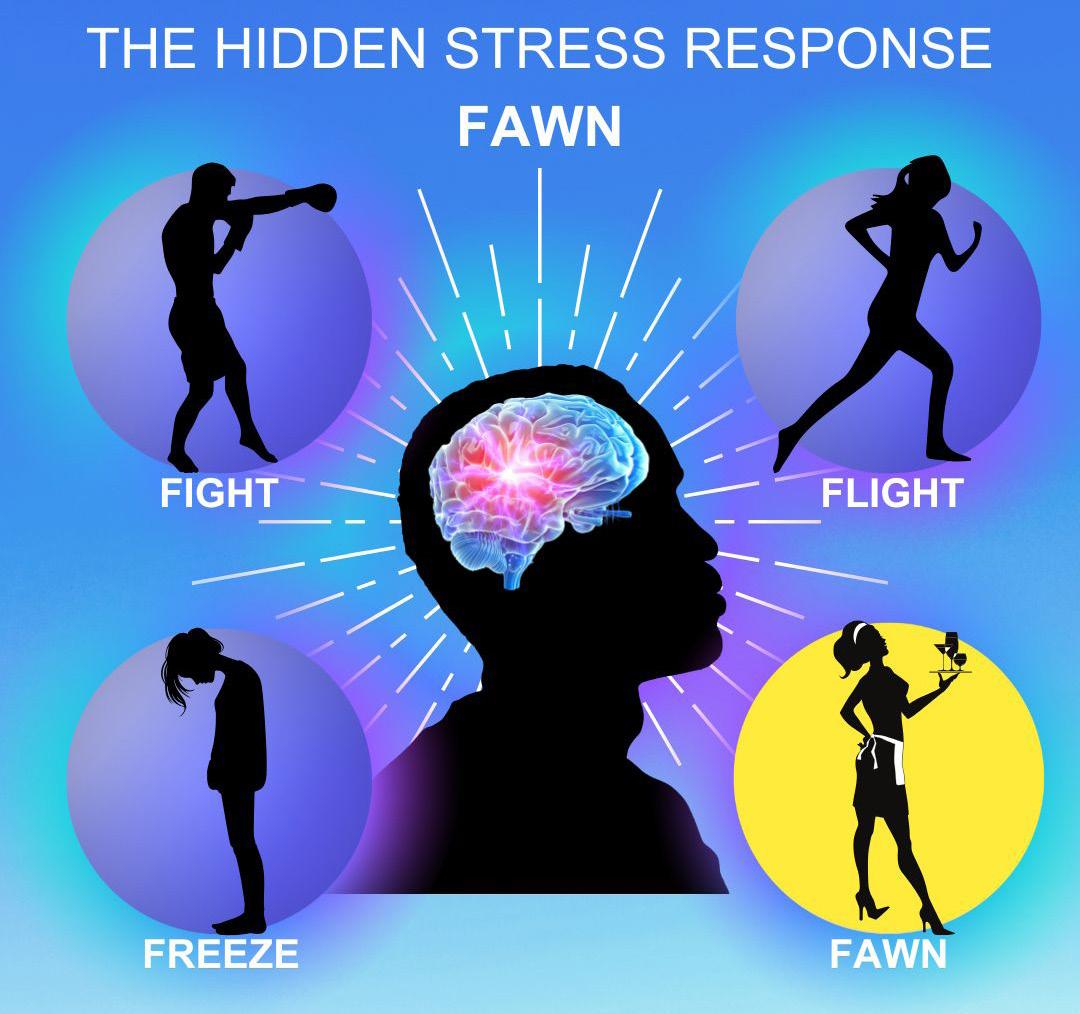
When people-pleasing is a stress response
According to Ashby, the fawn response often stems from childhood trauma. When caregivers are unpredictable — sometimes nurturing, other times neglectful — children may learn to become overly compliant to create a sense of security with their caregiver.
Navigating a stressful environment
Marti Smith, an interdisciplinary studies student at Cal Poly Humboldt, understands the toll of the fawn response. Growing up, her father’s alcoholism and her parents’ separation made her feel responsible for keeping the peace.
The cost of submission
“Even now, in my marriage, I see that I want any conflict to just go away,” Smith said. “Early in our relationship, I was terrified of having honest conversations. It was unhealthy, and it led to a point where my husband said, ‘I feel like I don’t even know you.’”
The fawn response and parenting
When a stranger touched her son's hair at Disneyland, Smith forced a polite smile.
“I was still so nice, even though inside I was like, ‘Did you just touch my son’s hair?!’” Smith said.
“At the time, I didn’t even know it
was fawning. I used to think it was freezing, but now I realize it was fawning,” Smith said. “Trying to keep the situation polite even when I was internally upset.”
Therapy can be a game-changer
For Smith, therapy helped her recognize and change her tendency to default to the fawn response.
“My therapist helped me understand that I wasn’t being deceitful or manipulative — this was a response I had learned to survive, and now I’m working on changing it,” Smith said.
Her relationship with her husband has improved as she’s learned to be more open.
“I’m much more transparent now, and that’s been huge. Before, I wasn’t showing up authentically, and it took a long time to break through that,” Smith said.
Lifting the self-blame burden
“The first step is learning about trauma and its long-term effects. This can be empowering because it helps people understand why they react the way they do,” Ashby said.
Reframe behavior with compassion
“It’s important to shift our thinking from ‘I’m a bad person’ to ‘This behavior was helping me survive when I was young,’” Ashby said. “Recognizing these patterns can create a sense of self-compassion, which is crucial for healing.”
This Stress Awareness Month, ask yourself: Are you prioritizing your well-being, or just trying to keep others happy? Remember, self-care and boundaries aren't selfish — they are necessary. If you need extra support, there’s a list of mental health resources on page 24. Be well!
*This article reflects the opinion of the author, not of the newspaper as a whole.
Disclosure:Disclosure:Atthebeginningof March,theauthoracceptedapositionasahealtheducatorwithStudent HealthServices,whichorganizationally fallsunderStudentHealth&Wellbeing Services.Counseling&Psychological Servicesisadifferentdepartment.
¿Sumiso bajo el estrés? Puede ser una respuesta al trauma
Escrito por Jessica de Laguna y traducido por Clari Gomez
Abril es el mes nacional de concienciación sobre el estrés, y eso significa que es hora de hacer una limpieza mental y emocional. ¿Alguna vez has dicho “si” cuando querías decir “no”? ¿Te desvías de tu camino para atender a los demás, aunque eso significa ignorar tus propias necesidades? Si es así, es posible que estés experimentando la respuesta del adulación- una respuesta al estrés en la que personas se sometan a otras personas ante las que se sienten amenazadas en lugar de responder con la lucha, la huida o la congelación.
La psicología del estrés
Erica Ashby, una trabajadora social clínica licenciada y administradora de casos en el centro de salud estudiantil en Cal Poly Humboldt, describe la respuesta de adulación como un estado de hipoalerta – un modo de desconexión, en contraste con los hiperalerta cargada de adrenalina de lucha o huida. Además, la respuesta de adulación se conoce a veces como “someterse”.
“Hay algunas diferencias de opinión sobre el estado de ‘congelación’ y sobre si entre dentro de la hiper o hipo excitación o es más bien una combinación”, dijo Ashby. “Cuando estamos en estado de lucha, huida, o congelación, esas respuestas consumen mucha energía. Están asociadas al dolor, el terror y la sobreestimulación”.
Al final, el cuerpo se ve obligado a descansar porque está agotado. Esto conduce a la hiperarousal, que es donde adula o sumisión viene.
“Si alguien te está gritando, una respuesta de adulación puede involucrar/ implicar disculparse profusamente y decir cualquier cosa que creas que le calmara”, dijo Ashby. “Intentas evitar el conflicto aunque eso signifique reprimir tus verdaderos sentimientos”.
Sumisión en el reino de animales
Sumisión es una táctica de supervivencia observada en el reino animal. En los primates, por ejemplo, un simio de rango inferior puede someterse a un líder dominante para mantener su lugar en el grupo y asegurarse el acceso a comida, refugio y protección. La respuesta a la lucha o huida ayuda en situaciones de riesgo - como escapar de un predador - pero la respuesta de sumisión puede ser igual de beneficiosa para la supervivencia.
Estrés conduce el agotamiento
Pero qué ocurre cuando el “simio dominante” en tu vida es tu jefe o pareja?
En vez de hacer valer tus necesidades, puede que optes por la sumisión y evites el conflicto a toda costa, aunque te lleve al agotamiento.
“Las personas que tienden a la
entiende el costo emocional de la respuesta de adulación. Durante su infancia, el alcoholismo de su padre y la separación de sus padres la hicieron sentirse responsable de mantener la paz.
“ Recuerdo que sentía que tenía que complacer tanto a mi padre como a mi madre”, dice Smith.”Había ciertas cosas

Las respuestas ocultas al estrés pueden afectar tu bienestar. No solo reaccionamos con lucha, huida o congelación, sino también con sumisión. ¡Busca apoyo si necesitas ayuda para comunicar tus límites y decir "no". Gráfca por Jessica de Laguna
sumisión suelen tener aversión a la confrontación porque nunca se han sentido seguras “, dijo Ashby.
Cuando complacer a la gente es una respuesta al estrés
Según Ashby la respuesta de adulación suele tener origen en un trauma infantil. Cuando los cuidadores son impredecibles - a veces cariñosos, otras veces negligentes - los niños pueden aprender a ser excesivamente complacientes para crear una sensación de seguridad con su cuidador.
Navegando un ambiente estresante
Marti Smith, estudiante de estudios interdisciplinarios en Cal Poly Humboldt,
que no compartía con mi madre porque quería hacerle la vida más fácil y cosas que no compartía con mi padre porque lo provocaría”.
El costco de sumisión
“Incluso ahora, en mi matrimonio, veo que quiero que desaparezca cualquier conflicto”, dice Smith. “Al principio de nuestra relación, me aterrorizaba tener conversaciones sinceras. No era sano, y me llevó a un punto en el que mi marido me dijo: ‘Siento que ni siquiera te conozco’ “.
La respuesta de adulación y la paternidad
Cuando un desconocido le tocó el pelo
a su hijo en Disneylandia, Smith forzó una sonrisa cortés.
“Sigue siendo muy amable, aunque por dentro pensaba: ‘¡Acabas de tocarle el pelo a mi hijo?!’ “, dijo Smith. “En aquel momento, ni siquiera sabía que era adulación. Solía pensar que era congelación, pero ahora me doy cuenta de que era adulación”, dijo Smith. “Intentaba mantener la cortesía en la situación incluso cuando estaba alterada internamente”.
La terapia te puede cambiar el ritmo de tu vida
En el caso de Smith, la terapia le ayudó a reconocer y cambiar su tendencia a la respuesta de adulación.
“Mi terapeuta me ayudó a entender que no estaba siendo engañosa ni manipuladora: era una respuesta que había aprendido para sobrevivir, y ahora estoy trabajando para cambiarla”, dijo Smith. La relación con su marido ha mejorado porque ha aprendido a ser más abierta. “Ahora soy mucho más transparente, y eso ha sido enorme. Antes no me mostraba con autenticidad, y me llevó mucho tiempo superarlo”, dice Smith.
Liberarse de la culpa
“El primer paso es aprender sobre el trauma y sus efectos a largo plazo. Esto puede ser fortalecedor porque ayuda a las personas a entender porque reaccionan de la manera en que lo hacen”, dijo Ashby. Reformular el comportamiento con compasión
“Es importante cambiar nuestro pensamiento de ‘soy una mala persona’ a ‘este comportamiento me ayudaba a sobrevivir cuando era joven’ “, dijo Ashby. “Reconocer estos patrones puede crear un sentido de autocompasión, que es crucial para la curación”.
En este mes de concienciación sobre estrés, pregúntate: ¿Estás dando prioridad a tu bienestar o solo intentas contentar a los demás? Recuerda que el autocuidado y los límites no son egoístas, sino necesarios. Si necesitas más ayuda, en la página 24 encontrarás una lista de recursos de salud mental. ¡Que te vaya bien!
Divulgación:Aprincipiosdemarzo, elautoraceptóunpuestodeeducadorade saludconlosServiciosdeSaludparaEstudiantes,quedependedelosServiciosdeSalud yBienestardelosEstudiantes.AsesoramientoyServiciosPsicológicosesundepartamentodiferente.
Disclosure: Inclusion on this list does not imply endorsement of services or organizations.
Counseling and Psychological Services (CAPS)
2nd Floor, Room 205
707-826-3236
Campus Advocate Team (CAT)
Support for survivors of sexual assault and domestic violence. 24-hour crisis line. 707-445-2881
ADHD and Neurodivergent Skills Group
Support for managing symptoms
Wednesdays, 2:30-4:30 p.m.
CAPS Group Room, SHC
Stephanie McMullen (sjm210@ humboldt.edu)
Queer Tea
LGBTQIA2S+ social support
Wednesdays, 4:30-6 p.m.
Siemens Hall 116
Alejandro Torres (at73@humboldt.edu)
Café con Chisme With El Centro
Latine student community space
Fridays, 2-3 p.m. (twice a month) Nelson Hall East 205 Alejandro Torres (at73@humboldt.edu)
Trans Support
Gender identity support group Wednesdays, 4:30-6 p.m.
Harry Griffith Hall 217 Lisa Turay (lmt21@humboldt. edu)
Men’s Circles with the Diverse Male Scholar Initiative (DMSI)
Men of color support Fridays, 3-4:30 p.m.
Balabanis House (SJEIC)
Antonio Barillas (ab489@humboldt.edu) or Agustin Valdez (jav6@humboldt. edu)
Give Your Brain a Break
Mindfulness for anxiety Thursdays, 3-4:30 p.m.
Library Fishbowl (Room 209)
Jennifer Blair (jes27@humboldt. edu)
ELITE Scholars Support Group
Safe space for support Thursdays, 4-5:30 p.m. Nelson Hall East 120 Jodi Smith (jls113@humboldt. edu)
Support for undocumented and mixed status students. Contact for details
Antonio Barillas (707-630-1621) or Scholars Without Borders (swb@ humboldt.edu)
Find local therapists through:
• North Coast Association of Mental Health Professionals: www.ncamhp.org
• Psychology Today: www. psychologytoday.com
TimelyCare (Free for Students)
24/7 emotional support, medical services, psychiatry (by referral), health coaching, guided meditation, yoga, and peer support. Register at timelycare.com/calpolyhumboldt or TimelyCare app
Humboldt County Behavioral Health (DHHS)
24-Hour Behavioral Crisis: Emergency psychiatric support, assessments, and referrals.
707-445-7715
Adult Behavioral Health Services:
Therapy, case management, and medication support.
707-268-2900
Transition Age Youth Services (TAY):
Support for ages 16-26. Drop-in hours Wednesdays, 1-4 p.m.
433 M St., Eureka. 707-476-4944
Children & Family Behavioral Health:
Therapy, case management, and medication services.
707-268-2800
Humboldt Domestic Violence Services
Emergency shelter, counseling, restraining order assistance, and more. 24-hour crisis line
707-443-6042
Humboldt Family Service Center
Sliding-scale mental health services. Medi-Cal accepted. 707-443-7358
Hospice of Humboldt
Free grief support groups and classes.
707-445-8443
Making Headway Center
Support services for individuals with brain injuries.
707-442-7668
North American Mental Health Services
Free phone-based therapy for Partnership Medi-Cal members. Psychiatry available. The Eureka Mall, Suite 33 888-292-8080
Open Door Community Health Centers
Information line for Open Door behavioral health services.
707-269-7073
Remi Vista
Counseling for children and adults (Medi-Cal & limited Blue Cross). 707-268-8722
Two Feathers Native American Family Services
Mental health programs for Native youth in Humboldt County. 707-839-1933
United Indian Health Services
Medical and behavioral health services for Native individuals. 707-825-5000
Mental Health America
Free text counseling for California Residents 571-601-3032
Suicide and Crisis Lifeline
Free, 24/7 confidential support during mental health crises. www.988lifeline.org Text: 988